Abstract
Recent advances in sensor technology are expected to lead to a greater use of wireless sensor networks (WSNs) in industry, logistics, healthcare, etc. On the other hand, advances in artificial intelligence (AI), machine learning (ML), and deep learning (DL) are becoming dominant solutions for processing large amounts of data from edge-synthesized heterogeneous sensors and drawing accurate conclusions with better understanding of the situation. Integration of the two areas WSN and AI has resulted in more accurate measurements, context-aware analysis and prediction useful for smart sensing applications. In this paper, a comprehensive overview of the latest developments in context-aware intelligent systems using sensor technology is provided. In addition, it also discusses the areas in which they are used, related challenges, motivations for adopting AI solutions, focusing on edge computing, i.e., sensor and AI techniques, along with analysis of existing research gaps. Another contribution of this study is the use of a semantic-aware approach to extract survey-relevant subjects. The latter specifically identifies eleven main research topics supported by the articles included in the work. These are analyzed from various angles to answer five main research questions. Finally, potential future research directions are also discussed.
1. Introduction
Recent advances in technology have had a great impact on today’s digital world, surrounded by billions of intelligent sensors integrated with the Internet of Things (IoT) [1,2]. In such a complex dynamic environment, IoT devices, which usually have limited computing power and small memory capacity, can constantly generate huge amounts of data that can be analyzed in remote cloud data centers. Wireless Sensor Networks (WSN) are considered to be one of the key technologies used for data generation in IoT components.
However, transferring data from where it is generated to a data center increases communication overhead and bandwidth consumption, and also raises privacy concerns. Thus, the use of cloud processing alone is clearly not the most efficient approach for real time systems (e.g., health monitoring, autonomous driving, smart city) [3]. Thus, it is necessary to conduct the computation of the data collected by sensors as locally as possible, incorporating intelligence from edge devices, to move computation from cloud to edge [4]. This means placing a kind of artificial intelligence close to edge devices capable of processing complex behaviors and adapting to rapidly changing situations. In addition, more than ever before, microcontrollers are powerful enough to make intelligent decisions without any external help based on data collected from various sensors [5]. These devices can also analyze data, transmit data to low-latency actuators, and only transfer summarized information to the cloud [6]. In short, adding some sort of intelligence to the sensor nodes represents the next step in fulfilling an “awareness” level to the edge [7,8,9,10]. If data from different sensors are appropriately combined, the integrated data can be more precise, more reliable or simply provide a better understanding of the context in which the data was obtained [11]. Thus, sensor fusion will continue advancing in almost all applications, including security, logistics, voice recognition, object detection, etc. In such a sensor environment, most of these applications focus on performance metrics such as latency, reliability and even security [12,13,14].
As new wireless technologies such as WiFi Direct, 5G, Zigbee, LoRa, NB-IoT and LiFi are rapidly being developed, Edge Computing (EC) will soon help transition processing and analysis from the cloud to the edge [15,16,17].
1.1. Our Contribution
The purpose of this study is to provide an overview and understanding of the theoretical background, challenges, approaches, motivations, and gaps for the implementation of intelligent context awareness in wireless sensor networks. This document presents a literature review that covers the analysis of research documents published in the period between 2015 and January 2022 and available from the Scopus and Web of Science databases. In previous related reviews, we have not found an exhaustive work that explores deeply intelligent solutions using artificial intelligence (AI), machine learning (ML), or deep learning (DL) algorithms and their contributions to building the context-awareness in various WSN applications. Moreover, this study can be distinguished from the existing related surveys through the following key contributions.
- Apply a semantic-aware approach to identify survey-relevant subjects.
- Identify and explore various AI/ML and DL methods that can be used in the establishment of a context awareness setting of sensor networks.
- Analyze key challenges and the research gaps found in the literature that need to be solved.
- Discuss the motivations for integration of intelligent context awareness in wireless sensor networks.
- Outline future research directions.
This investigation will fill the research gaps by comparing the included papers in terms of their challenges, strengths, limitations, motivations, and the way forward in the field. Furthermore, this review can help future researchers in identifying and exploring new perspectives in the field of sensor network context awareness field.
1.2. Organization of This Work
The rest of the paper is organized as follows. Section 2 introduces the technological context and discusses other surveys related to the topic of this study. Section 3 explains the methodology of this work. Section 4 analyzes the data extracted from included papers and discusses the results related to the defined research questions. Section 5 provides a discussion about industrial perspectives, context-aware challenges and corresponding intelligent solutions in a logistics use case. Finally, we conclude the paper with some open issues in Section 6. Figure 1 exhibits the organization of this paper.
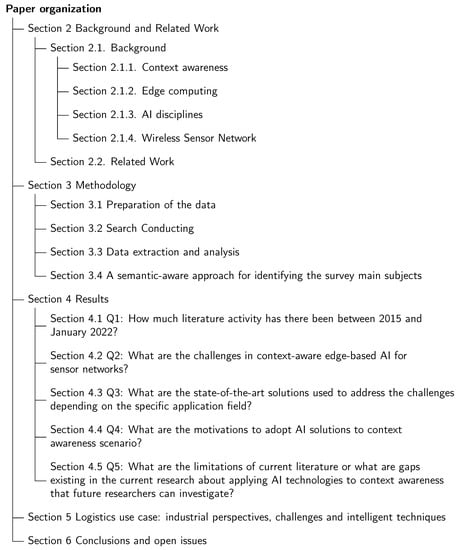
Figure 1.
A schematic illustration of the paper organization.
2. Background and Related Work
2.1. Background
This section introduces the technological context necessary to facilitate the understanding of the context-aware AI modeling challenges in edge environments. Firstly, in Section 2.1.1, we describe the main features of context-aware computing as a specific paradigm within the EC environment. Then, in Section 2.1.2, we present the basics of EC. Section 2.1.3 briefly discusses main concepts of AL, ML and DL. Finally, in Section 2.1.4, we focus on the role of sensors and present examples of applications that use sensors in dynamic environments.
2.1.1. Context Awareness
In recent years, context-aware applications have captured a lot of attention as they extract user context, such as location, activity, time, health status, physical environmental state, etc. Various types of special sensors are used. These can be physical sensors, such as the Global Positioning System (GPS) sensor and accelerometer, or virtual sensors, such as user calendar, weather web service and weather radar [18,19]. However, in a consensus definition, context awareness is defined as “systems that adjust according to conditions: environmental (e.g., the level of pollution), physical (e.g., one’s current location), social (e.g., one’s family and colleagues), or temporal (e.g., the time of the day), as well as changes in these things over time” [20,21]. As part of this article, context is defined as a situation and environment of sensors in WSN. Therefore, contextual information use includes interactions between sensor nodes and the reaction of sensor nodes to environmental changes to discover information of interest [21,22]. A context-aware system architecture is exhibited in Figure 2.
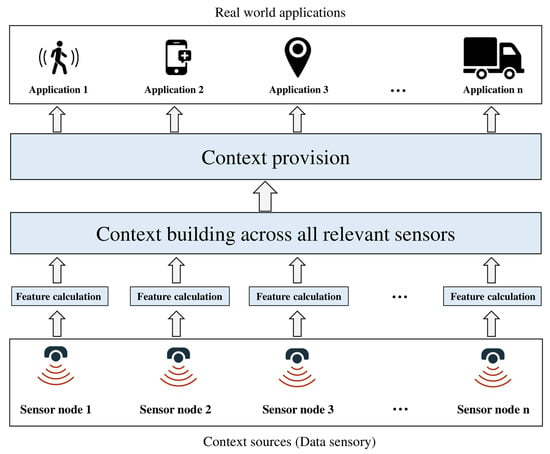
Figure 2.
Context-aware framework layers.
Sensor nodes typically have specific context metrics. Some examples of these metrics are location, energy level, connectivity, speed, temperature, pressure, and link quality.
2.1.2. Edge Computing
EC, a computing paradigm which extends cloud computing, enables all computing outside the cloud to happen at the edge of the network [23], and more specifically in applications where real-time processing of data is required. Lately, the “Edge” defines the point where sensor nodes and IoT devices are located in the local network [24]. EC works on a huge quantity of data generated by sensor nodes or users in the edge network [25]. However, with respect to context awareness, data generated either from a single sensor node or by multiple sensor nodes represent unprocessed data, while context information represents processed raw data [26]. EC system architecture consists of four primary components shown in Figure 3: centralized cloud, a centralized data processing system, operates on a massive amount of data that can be accessed at anytime. Edge data centers, are specialized data centers located closer to the edge than the cloud that deliver faster processing than edge devices, as well as minimal latency and data transmission costs compared to the centralized cloud in real time. Edge devices are pieces of physical hardware that send data between the local network and the central cloud. Traditional edge devices can include many different things, such as edge sensors, routers, firewalls, and chips. Sensor nodes are data accumulation sources. These technologies include edge sensors and chips which are capable of gathering, sensing, and processing data—to an extent.
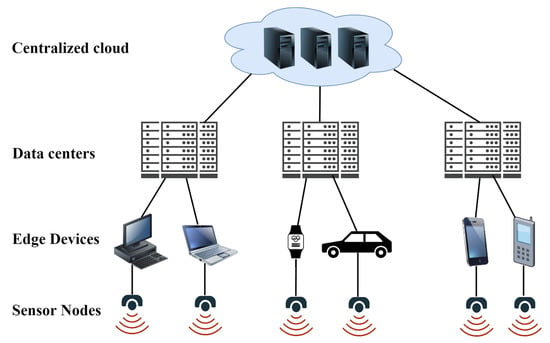
Figure 3.
EC ecosystem.
Three types of EC architectures have been introduced, namely: Mobile-Edge Computing (MEC), fog computing, and cloudlets computing [24]. MEC extends EC by providing compute and storage resources near to low energy, low resource mobile devices. While fog computing seeks to realize a seamless continuum of computing services from the cloud to the things rather than treating the network edges as isolated computing platforms. Cloudlets are small data centers that are typically one hop away from mobile devices [24]. These paradigms differ in terms of software architecture, context awareness, and location of nodes.
2.1.3. AI Disciplines
The definition of Artificial Intelligence (AI) was first coined by McCarthy in the 1950s, where the field of AI refers to the capability of a machine to imitate human intelligence processes [27]. The overall goal of AI research is to let machines perform some advanced decisions that require intelligent humans to complete. The main concern of AI was and still is to do tasks that are typically hard to characterize formally in terms of mathematical rules [28]. The difficulty of explaining this type of task showed that AI approaches needed the ability to find patterns and gain knowledge [28,29]. This ability is defined as ML, which allows computer applications to learn and act on data without explicitly programming it [30]. However, mapping the knowledge gained from learning to final prediction requires the implementation of methods classified as representation learning, in which features are converted into representations including useful information [31]. For complex concepts, if a representation is indicated in terms of other representations, DL needs to be used. DL allows computational models to learn representations with different levels of abstraction. Thus, DL can be seen as representation learning that can imitate human thinking and gain knowledge [28]. These days, AI, ML, and DL are three popular terms that are often used interchangeably to characterize intelligent systems. Their relations are shown in [32], in which, DL is part of ML and is also a part of the broad field of AI while ML is considered a part of the AI umbrella.
2.1.4. Wireless Sensor Network
The WSN, which is the backbone of IoT, consists of dedicated, small, resource-constrained, and low-cost sensor nodes that are randomly deployed in a monitoring environment to perform certain specific tasks over a period of time [33]. Current WSN are widely used in various applications, such as healthcare [34], smart homes [35], environment monitoring [36], etc. Each sensor node has a processing power, radio, and electrical storage device that converts a physical phenomenon of a heterogeneous environment into an electrical signal. The main task is to cooperatively sense, gather and process data about devices in the coverage region, and then transfer it to remote servers for deriving the information [37,38]. Figure 4 displays the typical WSN architecture which contains sensor nodes, fog nodes, and a central cloud.
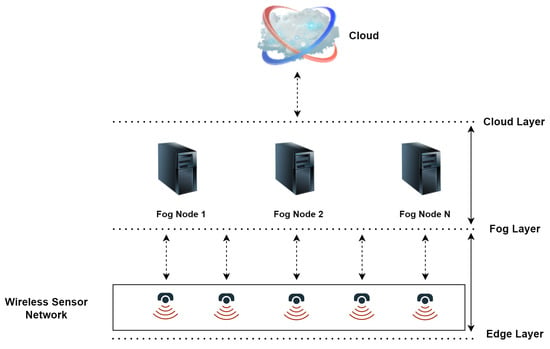
Figure 4.
A schematic presentation of the general WSN architecture.
A number of factors play a role in determining node failures such as harsh environments, restricted energy, and device faults. It is also necessary that the sensor network is able to support the task for a minimum specified period of time [39].
2.2. Related Work
With the aim of outlining the contribution of the present study over the existing related surveys, we provide herein a brief overview of these works. There are many surveys on the subject of context-aware computing, context-aware sensor networks and context-aware intelligence related to the subject of our study. Peraraet et al. [40] provide a framework for an overview of context-aware IoT that briefly describes how ML models work, but does not deepen this point. Furthermore, their proposed solutions are yet to be implemented in real time. In [41], a literature review focusing on the most common techniques in the development of context-aware systems is presented. However, they show that all methods have disadvantages and do not dive into a discussion of ML methods. Vahdat et al. [42] expose a survey study about specific application domains, namely Mobile Crowd Sensing (MCS) in smart environments. In [43], authors have aimed to understand the state-of-the-art in the development of context-aware middlewares (CAMs) for aiding the construction of HAR applications when using ML. However, they do not consider explicitly the sensor networks and they have focused only on HAR applications. Sezer et al. [44] focus on Data Analytics in Edge-to-Cloud environments. However, they do not deepen the discussion of ML for HAR. Bogale et al. [45] consider the AI approaches in the context of fog (edge) computing architecture, but the authors do not present a deep discussion of the various ML algorithms that are used. In Preeja and Krishnamoorthy’s study [46], authors have outlined the context characteristics, context organization, and context-aware systems, such as context modeling and the use of a middleware approach to simplify the development considering the heterogeneity of technologies. However, their survey has been developed in the context-aware middleware domain. The work in [47] brings an overview of significant concepts and related applications in various fields of context-aware systems. Although this work has presented a review of the latest development of context-aware systems during the period from 2008 through 2019, the authors present only a few discussions. Chatterjee et al.’s study [48], on the other hand, is the most relevant paper to our review. This paper has focused on identifying the current trends, foundations, and components of the envisioned IoT devices to enable the design of more efficient connected intelligent systems in the future. However, the authors do not deepen in a discussion of the type of AI, ML, or DL solutions that have been used to address the predefined challenges or dive deeper into a discussion of application domains. In [49], authors have focused only on the algorithms and modeling techniques used in context-aware recommenders. The purpose of our study is to fill the gap by considering recent advances in the field of context-aware edge-based AI models for sensor networks and by identifying application domain-independent challenges. Moreover, our work differentiates from the above-mentioned studies by applying a semantic-aware approach for identifying the main subjects supported by the survey included papers. Namely, the articles’ keywords are analyzed by clustering them into groups of semantically similar terms. Thus, in our survey we have managed to extract the major covered topics in its subject framework. Table 1 lists a comparison of our study with the various related reviews conducted in the period between 2015 and January 2022.

Table 1.
Overview of previous related surveys and comparison with our study with respect to their contributions and discussed intelligent techniques (classical AI, ML and DL).
3. Methodology
Given the latest changes that occurred on advances in edge computing with advances in artificial intelligence, the attention of academia/industries is predominantly focused on the state of the art in context-awareness systems, which are considered crucial for the realization of intelligent IoT and sensor network applications. Therefore, it is necessary to identify the state of the literature on the relationship between AI fields and edge computing to support context-aware sensing systems. To achieve this goal, the authors formulate research questions to define the scope of work.
Leaden by research questions listed in Table 2, this research was carried out by defining the below listed search criteria to gather all relevant publications. We divided this review of the literature into four main phases outlined in Figure 5: data preparation, search conducting, data extraction and analysis, identification of survey topics.

Table 2.
Research questions (RQs).
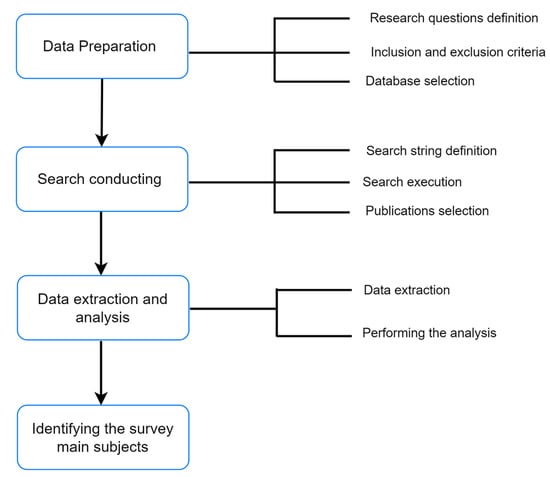
Figure 5.
The main methodological phases of the study.
3.1. Preparation of the Data
Based on the above research questions (Table 2), this study is focused on the following meanings: “context awareness”, “edge computing”, “artificial intelligence”, “machine learning”, “deep learning”, “sensors” and “wireless sensor network”. In addition to the main concepts, their synonymous were defined. The indexing databases considered for this study were Web of Science and Scopus, which were recommended for conducting a literature review by multiple researches in [50,51]. In line with the setup of the study, a list of inclusion and exclusion criteria were set to improve the selection of publications and to guarantee a successful analysis process. The inclusion criteria are:
- IC1.
- Journal and conference papers that address the intersection between context-aware, artificial intelligence methods, and sensor network domain, containing the terms in the title, or keywords. Papers with the terms just in the abstract are excluded in this study.
- IC2.
- Papers available in electronic form published between 2015 and January 2022.
- IC3.
- Journal and conference papers written in English.
The defined exclusion criteria are:
- EC1.
- Articles without access to the electronic file.
- EC2.
- Bibliographic, conference reviews, works of non-indexed or gray literature, and master thesis.
- EC3.
- Duplicate studies after reading the title.
- EC4.
- No relevance after reading title and abstract.
Then, the identified studies were sieved according to five defined filters, explained below.
- Filter 1 allows the retention of papers related to context-awareness and AI fields such as ML and DL for sensor networks. The search takes the TITLE + ABSTRACT + KEYWORDS fields as a whole, making those 3 fields into just one and then running a text search (IC1).
- Filter 2 allows the retention of publications available in electronic form and published between 2015 and January 2022 (IC2). Articles without access to its electronic file are discarded (EC1).
- Filter 3 includes only publications journal and conference papers written in English (IC3). It also allows the removal of bibliographic, conference reviews, works of non-indexed or gray literature, and no research thesis (EC2).
- Filter 4 allows the removal of duplicate or redundant publications (EC3).
- Filter 5 allows the removal of irrelevant papers. The authors of the current survey have conducted this task by reviewing the title and abstract of each paper and selecting only papers that are related to the topic of the survey (EC4).
3.2. Search Conducting
Considering the above-defined research questions, the main focus was papers from the most reputed scientific databases, namely Web of Science and Scopus, during 2015–January 2022. Table 3 presents the search strings of this study.

Table 3.
Search strings considering the search process strategy with inclusion and exclusion criteria.
3.3. Data Extraction and Analysis
Initially, a search of scientific papers from the Web of Science and Scopus databases was performed to extract the publications from the selected sources. The selection criteria were divided into the five filters discussed above in order to collect more relevant articles. Therefore, the selection process comprehended the phases depicted in Figure 6 and followed the procedures outlined below:
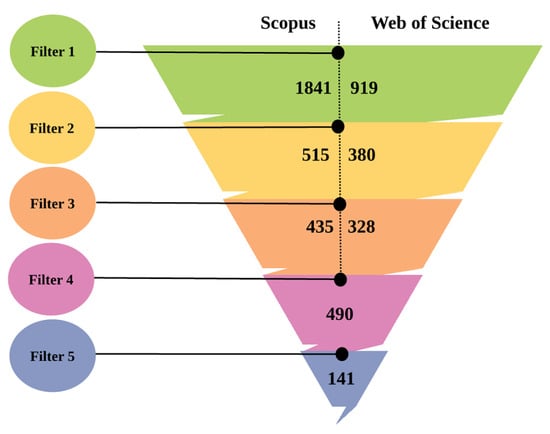
Figure 6.
The number of papers selected after applying each filter of the survey’s related papers is given for WoS and Scopus databases, respectively.
- A total of 2760 publications related to context-awareness and AI fields were retrieved, of which, 1841 were obtained from Scopus and 919 from Web of Science.
- As a result of the second filter, 515 publications from Scopus and 380 publications from Web of Science were retrieved, available in electronic form and published between 2015 and January 2022 with access to its electronic file.
- Only publications in journals and conference papers written in English were retained. Bibliographic, conference reviews, etc., were excluded. Thus, 435 documents for Scopus and 328 for Web of Science were retrieved as a result of the third filter.
- After merging the publications of Scopus and Web of Science, 763 duplicate publications were removed in the fourth filter, and 490 left.
- After reading the title, abstract, and keywords of these publications, 349 were eliminated because they were not related to the topic of the survey. At the end of the fifth filter, 141 papers were left. These are included and examined in this work.
After we managed to extract and classify the data, the aggregated data were then analyzed to be used to respond to the research questions in Section 4.
3.4. A Semantic-Aware Approach for Identifying the Survey Main Subjects
We have applied a semantic-aware approach for identifying the main subjects supported by the survey-related articles. The approach is built upon the analysis of the articles’ keywords. Initially, all different (unique) keywords of the extracted articles are gathered together. The number of all unique keywords is equal to 637. Then, this number is reduced to the most frequent keywords. Namely, a score is assigned to each keyword reflecting its frequency of appearing among the articles’ keywords. Then, all keywords which scores are below the preliminary defined threshold (2 in our consideration) are filtered out, i.e., only the most frequent 82 keywords are left. The applied approach uses the semantic similarity between keywords to identify the main research/application subjects covered by the survey. It is based on the idea published in [52]. In order to be able to apply this approach we have manually associated each keyword (from the most frequent ones) with its synonym keywords. This assists us in calculating the semantic similarity between keywords based on the common synonymy between two keywords by using the Jaccard coefficient [53]. Thus, the semantic similarity between two keywords and can be computed as follows:
where and are the synonymy numbers of and , respectively, and is the synonymy common number between and . The keywords then can be partitioned into groups of semantically similar keywords by applying a selected clustering algorithm (e.g., DBSCAN). The obtained clusters of keywords represent the main research/application subjects supported by the selected articles. The flowchart in Figure 7 illustrates the process of identifying main survey subjects. We have identified 11 of these subjects presented in Figure 8. The 11 keyword groups and the title of their subjects are shown in Table 4. In addition, the relative percentage of cluster size produced by applying DBSCAN with = 0.3 on the 82 most frequent keywords are also elaborated in Figure 8. The parameter specifies how close data points (keywords) should be to each other to be considered a part of a cluster. We have experimented with different values of and 0.3 has produced the most balanced grouping without any outliers.

Figure 7.
Flowchart describing the different steps of the semantic-aware approach applied to identify the main subjects covered by the included papers.
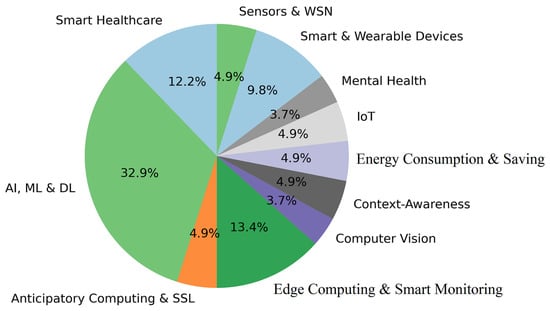
Figure 8.
Relative popularity of the identified subjects assessed on the based of the keywords’ frequency. The most popular subject is AI, ML and DL followed by Edge Computing and Smart Monitoring, Smart Healthcare and Smart and Wearable Devices.

Table 4.
The identified eleven clusters of keywords along with the titles of the subjects (cluster labels) they represent.
The selected articles can be further analyzed with respect to identified subjects to obtain deeper insight into the limitations and gaps in the current research related to the survey theme (Q5). For example, each article can be represented by a vector of membership degrees of the article to the different subjects (clusters of keywords). The membership degree of article i to subject can be calculated as , where is the number of keywords from the keyword list of article i that belong to cluster and is the total number of keywords describing article i. In this way, a fuzzy distribution of the articles among the identified subjects is obtained.
The fuzzy grouping of the articles can easily be transferred into a non-fuzzy clustering by associating each article to only subject(s), for which it has the highest membership degree. This allows us to evaluate the popularity of each subject quantified by taking into account the number of articles belonging to it (see Figure 9). Each group (research/application subject) can be associated with specific AI/ML techniques and domains of application by further analysis of the challenges and application domains addressed by the articles assigned to it. The knowledge extracted due to this analysis can be used to answer Q2, Q3 and Q5 by facilitating the identification of under/over-represented topics in the current research along with the challenges shared among different application fields. Each cluster of articles can also be studied with respect to the state-of-the-art solutions used to address the issues in the research/application subject presented by this cluster (Q3). The articles can also be grouped with respect to the identified subjects by using their membership degree vectors to measure the similarity between each pair of articles. In comparison with the grouping produced by the first approach where each group of articles is related to one concrete subject, in the current clustering the articles that are grouped together will be similar with respect to more than one research/application subject, e.g., we can identify articles that use the similar AI/ML techniques and at the same time deal with issues in the same application fields. As a result of this grouping the studied articles have been distributed in 15 disjoint clusters. We have experimented with different values for the parameter . However, all of those have produced clustering solutions where some of the articles are considered to be outliers. This is due to the scatter of articles in terms of topics, i.e., most of the articles are related to no more than two topics. The value 0.4 for the parameter is chosen, since it has produced the less number of outlying articles.
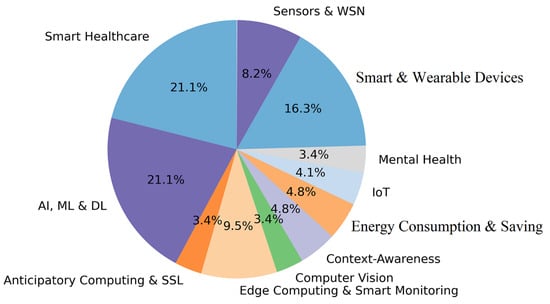
Figure 9.
Percentage of papers of sample studied per the main identified subjects. The most represented subjects are AI, ML and DL and Smart Healthcare followed by Smart and Wearable Devices, Edge Computing and Smart Monitoring and Sensors and WSN. These well reflect the survey theme.
As one can see in Table 5, the top ten keywords that appear the most in the articles included in this review are “ML”, “DL”, “IoT”, “activity recognition”, “sensors”, “HAR”, “wearable sensors”, “CNN”, “classification” and “context-awareness”, i.e., the review perimeter is well outlined by those.

Table 5.
Top ten most frequently used keywords.
Figure 9 presents the percentage of papers of sample studied per the eleven major subjects identified. The references to the papers related to each subject are given in Table 6. In addition, as it was discussed before the popularity of each identified subject is assessed relatively with respect to the others by taking into account the frequency of the keywords assigned to its cluster. This is represented by a pie chart in Figure 8. Interestingly, the four most popular subjects (see Figure 8) identified based on the keywords’ frequency coincide with the four subjects supported by the quantity of the published papers (see Figure 9). These subjects are AI, ML and DL, Smart Healthcare, Smart and Wearable Devices and Edge Computing and Smart. However, AI, ML and DL has a much higher percentage than Smart Healthcare with respect to the keywords’ frequency while these subjects are equally represented with respect to the published papers. This may be due to the fact that in the case of Figure 9, some papers are cross-disciplinary, i.e., they have the same highest membership degree to more than one subject and in that way, they are counted for all those subjects. One can also notice that Context-Awareness and Energy Consumption and Saving have the same representativeness in both Figure 8 and Figure 9. In addition, the two least popular subjects (Mental Health and Computer Vision) are identical in both figures.

Table 6.
The main subjects along with the references to their related papers.
As it was mentioned above, Table 6 exhibits the paper references belonging to each subject and how many belong to these primary subjects. Smart Healthcare stands out with 35 papers. AI, ML and DL and Smart and Wearable Devices are second and third, with 34 and 31 documents, respectively. In the fourth position, it can be found the Sensors and WSN with 17 documents, followed by the Edge Computing and Smart Monitoring with 16 papers. The number of included papers for Computer Vision and Mental Health is equal, i.e., only 5 papers are assigned to each one. It is worth noting that most of these studies, as can be seen in the table, belong to more than one subject, since their keywords are distributed among various clusters of keywords (main subjects).
4. Result Analysis
We have analyzed the data extracted by the selected publications (see Section 3.3) to answer each research question presented in Table 2. The research questions are addressed one by one in the following subsections.
4.1. Q1: How Much Literature Activity Has There Been between 2015 and January 2022?
We have reviewed the significant research papers in the field published from 2015 to January 2022. Figure 10 presents the details of the year-wise publications (publishing trend). A clear increasing interest in the recent years can be seen from that figure. For each year, we show the total number of papers normalized on monthly base. The highest number of papers published per year are after 2020. This demonstrates not only highly increased interest, but also the high need of research in intelligent context-aware WSNs.
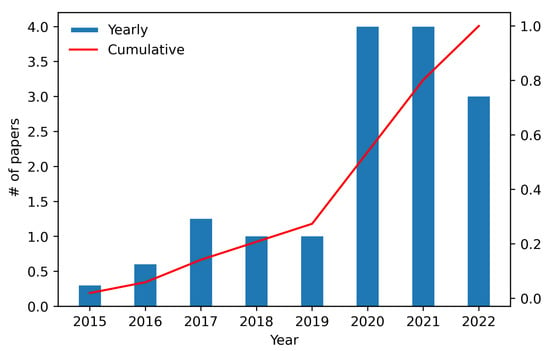
Figure 10.
Included papers per year (publishing trend) normalized on monthly base. There was a significant increase in the number of included papers published after 2019.
Moreover, the included papers per year are analyzed and distributed in four groups based on the used computational techniques, i.e., ML, DL, ML and DL and AI. These are presented in Figure 11, showing a significant increase in the use of DL in the studies published after 2019 with the expectation that this will continue to flourish in the following years. In addition, one can notice after 2019 the appearance of studies using AI modelling and reasoning techniques such as fuzzy logic.
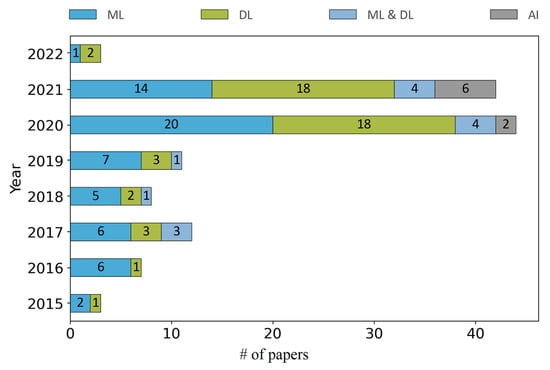
Figure 11.
Included papers per year are distributed in four categories based on the used computational techniques, i.e., ML, DL, ML and DL and AI.
4.2. Q2: What Are the Challenges in Context-Aware Edge-Based AI for Sensor Networks?
In order to answer the question Q2, the main challenges have been identified and are shown in Figure 12. These are Human Activity Recognition (HAR), monitoring, Quality of Service (QoS), energy saving, activity recognition, object detection and location-based service (LBS). They have been addressed by various AI, ML and DL approaches under different application domains as this will be discussed in the answers of the next research question.
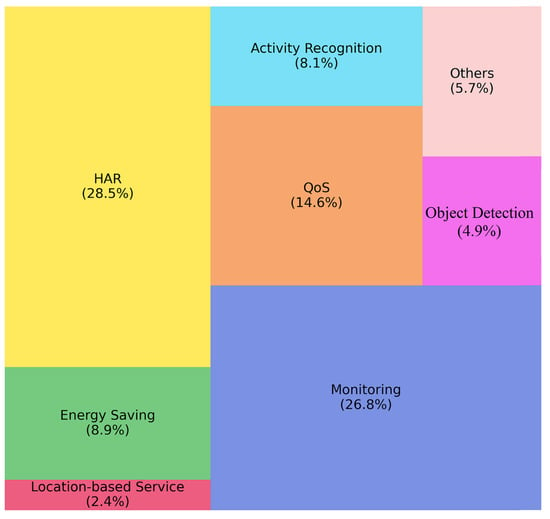
Figure 12.
Main challenges addressed by the papers included in the survey.
According to Figure 12, HAR is the top-addressed challenge, namely in of the sample. HAR includes recognizing daily performed locomotion modes [54,55,56,57,153,154], analyzing the behavior of the elderly in daily life [58,134,135], gait analysis [59,155,156,157], etc. Monitoring is the second most studied issue, namely in of the included papers. Not surprisingly, in the context of monitoring, various applications have been identified, e.g., health [60,89,115,158,159], smart buildings [90,116,160], agriculture [161,162], stress [61,117,136,163], transportation [91], military defense [164], etc. Other challenges comparatively highly studied in the included papers are QoS [92,93,118,128,137,138,139,152,165,166,167,168,169,170,171,172,173,174] with , and energy saving [62,63,94,95,96,114,119,142,143,144,175] with .
4.3. Q3: What Are the State-of-the-Art Solutions Used to Address the Challenges Depending on the Specific Application Field?
As it was already discussed in the answer of Q2, the two most studied challenges are HAR (28.5%) and monitoring (26.8%), followed by QoS (14.6%), energy saving (8.9%) and activity recognition (8.1%). In addition, as one can notice in Figure 12, LBS is investigated only in 2.4% of the sample. In order to answer Q3, we have initially explored the relationships of these challenges with the application fields addressed in the included papers. The studied application domains are presented in Figure 13.
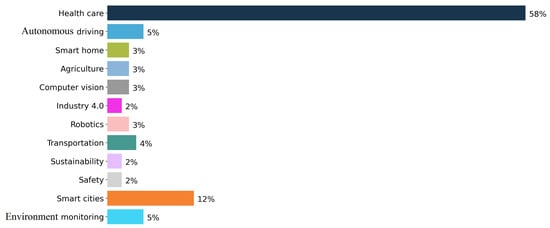
Figure 13.
Percentage of papers of sample studies per domain of applications. The most popular category is healthcare followed by smart cities, autonomous driving, environment monitoring and transportation (logistics).
The top explored category is healthcare studied in 58% of the included papers. It is followed by smart cities (12%), autonomous driving (5%), environment monitoring (5%) and transportation/logistics (4%). All the other categories are below 3%.
It is interesting to study the relationships among the five most studied application domains, the top addressed challenges and used intelligent techniques. In that way, two types of connections will be revealed: one between the state-of-the-art solutions used to address the identified main challenges and the other between the addressed challenges and corresponding application fields used to evaluate the proposed intelligent solutions. This will outline the technological and application perimeter of the context-aware intelligent systems for sensor networks. In addition, Section 5 discusses the identified challenges along with the intelligent techniques used in the logistic use case that has inspired this study.
Figure 14 illustrates the relationship between the HAR challenge and top five application domains. As can be seen in the figures, 66.7% of health care studies have addressed the HAR challenge. Smart cities and transportation are the second and third, with 14.8% and 11.1% of the papers studying this challenge, respectively. HAR is logically less explored in environmental monitoring and autonomous driving applications.
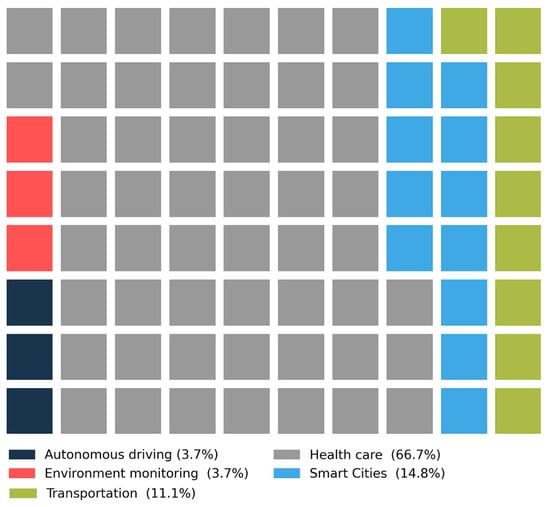
Figure 14.
The relationship between HAR and top five most studied application domains.
Furthermore, Figure 15 depicts the relationship between QoS with the top five application domains. Healthcare is again the most studied application domain (38.5%), followed by smart cities, transportation, autonomous driving and environmental monitoring sharing the equal interest (15.4%) in the included papers.
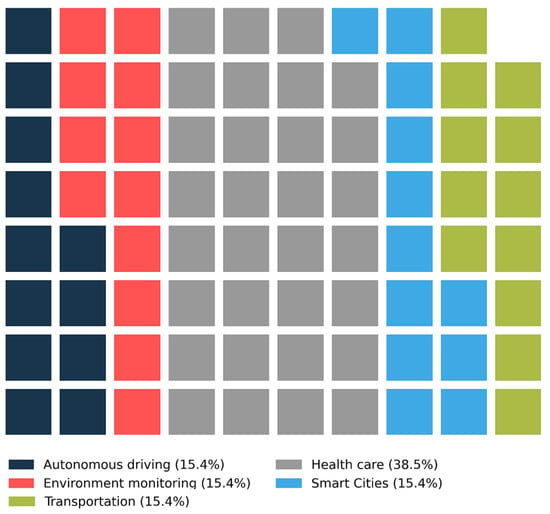
Figure 15.
The relationship between QoS and top five most studied application domains.
In addition, we study the relationships of the identified challenges against AI techniques applied. Figure 16 illustrates the relationship between the HAR challenge and intelligent techniques used to address it in the included papers. According to this figure, 41.4% of the papers studying HAR challenge use traditional ML approaches for handling it, in 44.8% of the papers DL techniques are applied, while in 10.3% of the studies ML and DL approaches are applied together to address this challenge, and only in 3.4% of the papers addressing HAR, AI methods have been employed.

Figure 16.
The relationship between HAR challenge and AI techniques categories used to address it.
Furthermore, Figure 17 depicts the relationship between the QoS challenge and intelligent methods used to address it. We can observe that in 61.5% of the studies ML techniques have been applied to solve this challenge, in 30.8% of the papers DL methods have been preferred, and AI techniques are only 7.7% of the included papers devoted to QoS.

Figure 17.
The relationship between QoS challenge and corresponding AI techniques categories used to deal with it.
Figure 18 visualizes, respectively, the relationships between the energy saving challenge and intelligent approaches used to address it in the studied papers. It is worth mentioning that the same trend is observed for the activity recognition challenge.

Figure 18.
The relationship between Energy Saving challenge and AI techniques categories applied to address it.
Figure 19 presents the more frequently used ML/DL algorithms in addressing HAR challenge. We can observe that Decision Tree (DT) (ML) and Convolutional Neural Networks (CNN) (DL) are equally used to address this challenge, namely in 17% of the papers studied the challenge. In addition, 17% of the studies have applied various other approaches such as Linear Regression (LR), active learning, fuzzy logic, etc. Neural Networks (NN) are mentioned only in 13% of approaches, while Random Forest (RF) and Support Vector Machine (SVM) have been implemented in 10% of proposed methods addressing HAR challenge.
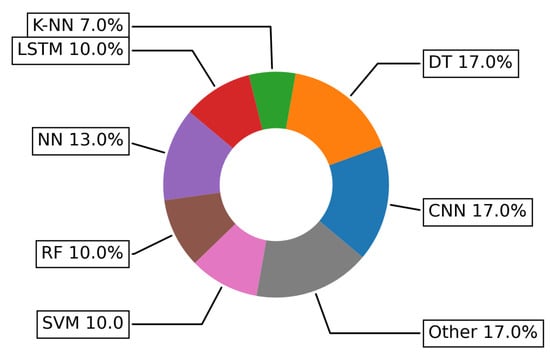
Figure 19.
Specific ML and DL algorithms more frequently used in addressing the HAR challenge.
Figure 20 depicting specific ML/DL techniques used to address Monitoring challenge shows that in contrast to HAR challenge, a lion’s share (23%) of techniques used is for SVM, followed by 17% for RF and then K-Nearest Neighbor (K-NN) and CNN taking the equal percentage (11%).
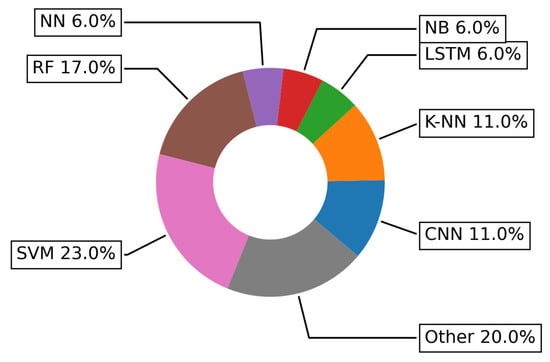
Figure 20.
Specific ML and DL algorithms more frequently used in addressing the Monitoring challenge.
Figure 21 depicts the trend donut chart of the ML and DL approaches that have been applied in addressing the Activity Recognition challenge. The results show that two DL techniques (CNN and Recurrent Neural Network (RNN)) and traditional LR are sharing the same percentage of usage, namely 20% of each one, while Deep Neural Network (DNN), K-NN, RF and SVM have also shared the equal usage percentage, but twice lower (10%).
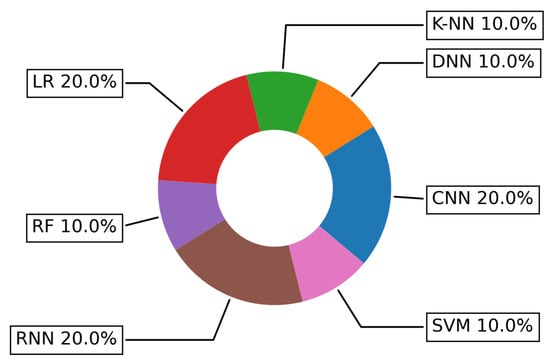
Figure 21.
Specific ML and DL algorithms more frequently used in addressing Activity Recognition challenge.
It is worth mentioning that 25% of methods used to address the QoS challenge apply DT while techniques such as CNN, RF, Naive Bayes (NB), K-means and Q-learning have been used only by 12% of the approaches. The analysis of the Energy Saving challenge reveals that 38% of approaches utilized are based on Long Short-Term Memory (LSTM), while each of the techniques K-means, RF, CNN, RNN and DNN has been used in 12% of the studies devoted to this challenge.
With regard to the state-of-the-art solutions used to solve the identified main challenges, we initially analyzed the sample of selected studies from the view of AI. Studies using fuzzy logic techniques are of articles, while studies using various other approaches to ML/DL approaches have the attention of of articles. In the discussed papers, see Figure 22, the review of the sample studied through the ML lens shows that the most used ML techniques are SVM, RF, DT and K-NN. For example, SVM and RF approaches are used by and of the selected articles, respectively. DT and K-NN are identified in and of the studies, respectively. While the clustering techniques are applied only by of the selected papers. Regarding other ML techniques used, are applied by sample studies.
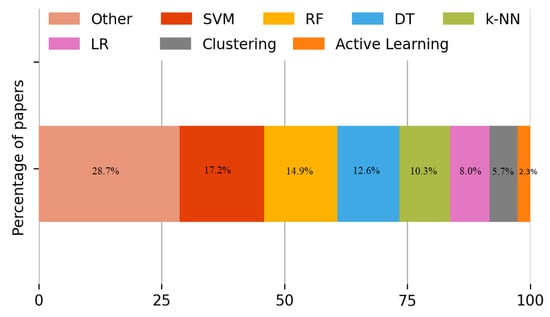
Figure 22.
Percentage of papers per ML category of algorithms found in the sample studied. The most used ML techniques are SVM, RF, DT and K-NN.
From the sample studied of DL discipline, illustrated in Figure 23, papers considering CNN are the most numerous, representing . NN are discussed in of the studies, while LSTM is used by of the sample papers. The use of Reinforcement Learning (RL) and DNN is found in of the articles.
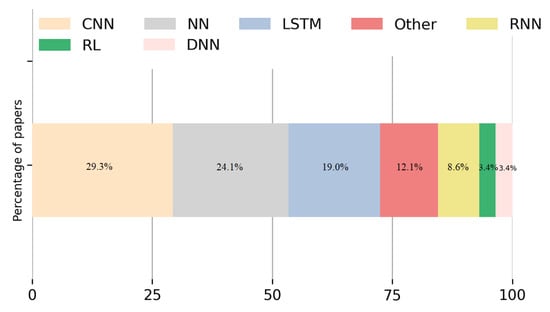
Figure 23.
Percentage of papers per DL category of algorithms found in the sample studied. The three most applied DL techniques are CNN, NN and LSTM.
Figure 24 illustrates the percentage of usage of the ML and DL approaches in the selected studies. The diagram shows that of selected papers have used ML techniques such as SVM, RF, K-NN, clustering, etc., while addressed the edge-based AI challenges by DL approaches such as CNN, NN, LSTM etc. In addition, we have found that of the papers use ML and DL together to address different challenges in context-aware scenarios.
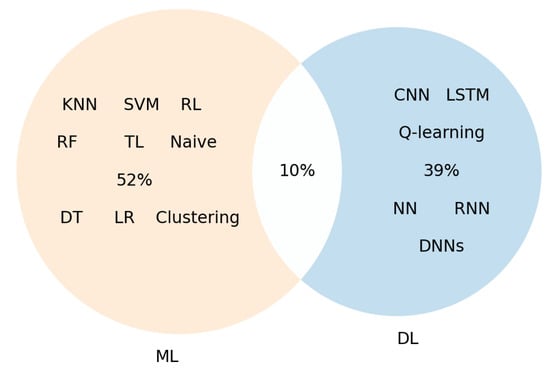
Figure 24.
Overview of ML and/or DL techniques that have been used in the included papers.
Table 7 presents an overview of selected studies that used ML and DL techniques to address challenges in context-aware scenarios and highlights the techniques used in each of them.

Table 7.
Various ML and DL techniques used in context-aware scenarios for sensor networks.
4.4. Q4: What Are the Motivations to Adopt AI Solutions to Context Awareness Scenario?
The motivations for applying AI/ML approaches to context-aware scenarios identified in the included studies are shown in Figure 25.
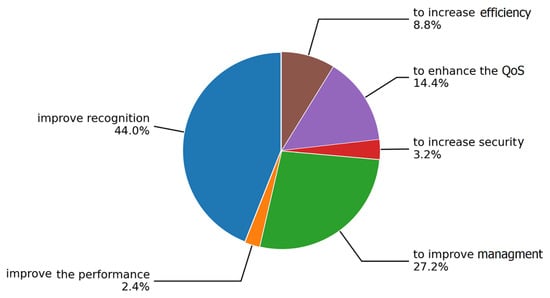
Figure 25.
Motivations of adopting AI solutions to context awareness.
The results show that of the studies have a motivation to improve the recognition. Some of these are proposed to recognize human activity with the wearable devices [54,59,72,82,85,153] or to ease the finding of objects [87,129,151], or to recognize the emotion [98,113]. Another motivation is related to management which refers to the configuration, maintenance, and monitoring (), such as monitoring the elderly [134,135] or detection of health-related problems [58,69,80,115,158], detection of abnormal driving behavior [64], etc. QoS is also an important motivation with , as optimization of resource-constrained IoT devices [137,169,173], or forecast the connectivity and bandwidth of mobile devices [139]. In addition, data privacy and security are another significant motivation, as to address the data privacy concern in healthcare applications [92,165], or in autonomous driving [166], or to improve access control techniques of smart devices [118]. Improving the performance of location-aware applications is the motivation used in of the selected studies, e.g., in location tracking applications [101,178] or in autonomous driving technology [109].
4.5. Q5: What Are the Limitations of Current Literature or What Are Gaps Existing in the Current Research about Applying AI Technologies to Context Awareness That Future Researchers Can Investigate?
The papers included in the survey are analyzed from three main perspectives: used state-of-the-art (AI, ML, and DL) techniques, application domains, and addressed challenges. The identified limitations and gaps in the study are discussed in light of these three perspectives.
As a result of the analysis conducted in Section 4.3, we have identified the lack of unsupervised and semi-supervised approaches that allow for dealing with the cases of not enough or entirely missing labeled data as well as transfer learning techniques in the reviewed state-of-the-art solutions. These can be considered as a particular gap calling for future research and development of techniques dealing with those challenges typical for most context-aware real-world scenarios. In addition, the current state-of-the-art research in the context-aware intelligent systems is lacking solutions in the framework of collaborative learning where several smart devices share insights from the local training, without sharing the raw data, namely decentralized and distributed learning schemes such as Federated Learning [179] and Swarm Learning [180].
The second perspective that has been studied in the included papers reviews the application domains used to evaluate the proposed intelligent context-aware solutions. Figure 13 exhibits that healthcare domain is studied in more than half of the papers (58%). The percentages of the other identified application domains are very low in comparison to that of healthcare, see the discussion presented in Section 4.3. For example, logistics/transportation domain which is in the focus of our special interest (see Section 5) is studied in only 4% of the reviewed papers. More than the half of the application domains (e.g., smart homes, agriculture, computer vision, Industry 4.0, robotics, sustainability and safety) are even below this percentage, only smart cities show a higher representation, namely the domain is mentioned in 12% of the papers.
Finally, from the perspective of the challenges identified (see Section 4.2), we can observe in Figure 12 that location-based services are understudied, mentioned in only of the reviewed articles. The interest in studying energy saving, activity recognition and object detection is also not very high, below 10%, which is quite lower in comparison with HAR and monitoring, each one explored in more than 25% of the studies included.
5. Logistics Use Case: Industrial Perspectives, Challenges and Intelligent Techniques
The current survey is inspired by an industrial use case in smart logistics. This and the fact that this application domain is less studied in comparison to the other top four fields motivated us to provide with an additional discussion of the industrial perspectives in logistics, the challenges identified along with the corresponding intelligent solutions used to addressed them.
Logistics is the backbone of global trade with global logistics expenditures making up between 10 to 15 percent of the total world GDP [181]. It is a high volume and low-margin market with many actors, turning supply chains into very complex operations with numerous logistics partners involved in each shipment. Because of this complexity, visibility into where goods are at a given moment, if they have been handled correctly, and if they are going to be delivered on time is a difficult goal to achieve. Most transportations lack visibility and traceability of what happens during the journey, making it difficult to answer when goods will arrive.
With the emergence of IoT trackers, tracking of individual goods has become possible by attaching a tracker on goods instead of manually tracking supply chain segments, such as individual lorries or containers. The decreasing footprint and price point of IoT devices have additionally enabled the ubiquitous deployment to not only high value goods and entire pallets, but to also individual items.
Due to the mobile nature of trackers, they are essentially battery-operated and function in environments where charging is often limited or nonexistent. Trackers often undergo shipment in demanding environments, such as containers and warehouses, in which wireless communication is unattainable and incur a high energy cost. In addition, trackers are often equipped with other sensors, such as temperature and accelerometer, each with their own energy profile. Altogether, trackers need to operate during the entire length of a transportation, while sensing and reporting significant events along a route and maintaining a sufficiently low energy profile.
With the ubiquity of small form factor AI computing and individual goods level tracking, the possibility for trackers to sense their environment and adapt behavior accordingly, both individually and collaboratively together with other devices, has become attainable. As an example, trackers can uncover relations between the device and its operating environment in order to adjust their sensing and operating profiles. For example, detecting indoor/outdoor and providing this context-aware information in various environments may be helpful and lead to battery-saving solutions [182]. In addition, multiple trackers can work in unison to make distributed decisions and utilize sensor sharing for improved power efficiency [183].
The study published in [184] identifies research in the context of intelligent transport logistics as performance enhancing approaches that combine multiple modalities of information technology and sensing into a real-time transportation management system using AI and ML. A central challenge posed by the authors stemming from the black-box nature of AI systems, lies in identifying and finding solutions for mitigating the effects of biased decisions taken by artificial intelligence. Given the advent of continuously learning AI systems wherein decision-making is updated given new input, we believe that this challenge will receive an increasing importance and focus. It is also important to note that the main challenges addressed in the studied papers in logistics domain are HAR, QoS, and monitoring as it is shown in Figure 26. The monitoring challenge is in the focus of 50% of the sampled papers, while each of HAR and QoS is studied in 25% of the logistics devoted papers.

Figure 26.
Main challenges in logistics addressed by the papers included in the survey.
In addition, AI categories identified from the included studies in logistics are shown in Figure 27. Interestingly half of the papers in logistics have used DL techniques, namely CNN, while one-quarter of the papers included have utilized ML and AI equally. This once more confirms the finding identified in [184] concerning the black-box nature of the most existing intelligent solutions in logistics and the need for new more transparent approaches.
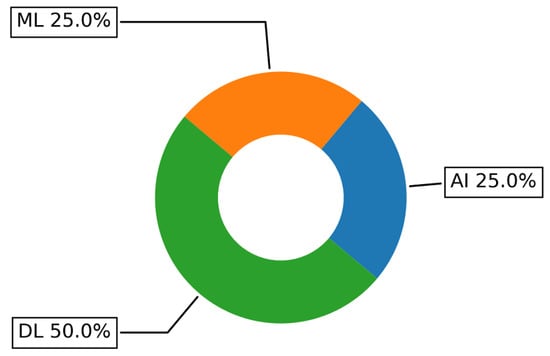
Figure 27.
Main AI techniques in logistics addressed by the papers included in the survey.
6. Conclusions and Open Issues
In this paper, we have provided an extensive survey of context-aware edge-based AI methods for WSN technology. Five research questions have been addressed by analyzing 141 research articles used as primary papers. Initially, we have applied a semantic-aware approach for analyzing the keywords of the included papers in order to extract the survey main subjects. Eleven such topics have been identified, e.g., the most popular are AI, ML and DL, Edge Computing and Smart Monitoring, Smart Healthcare and Smart and Wearable Devices. In the analysis carried out, we have also discovered that healthcare, smart cities, autonomous driving, environmental monitoring, and transportation are the top five application domains. Improving the quality of recognition, efficient management, enhancing QoS and efficiency, and ensuring higher security are the top five motivations for enabling intelligent applications in context-aware systems.
Various AI-based solutions have been studied in the included papers. Unsupervised and semi-supervised algorithms, as well as transfer learning techniques are identified as ones that have not grabbed much attention of researchers in most context-aware scenarios. Moreover, other promising collaborative frameworks such as federated learning and swarm learning have not been adequately explored. There is also a lack of research covering the location-based services in the reviewed articles, further studies with more focus on these challenges is highly suggested.
Our future research plans include deeper investigation of the challenges and gaps identified due to the conducted survey in order to expand further the knowledge gained and use those to develop new efficient intelligent edge-based solutions. For example, we are particularly interested in developing decentralized resource-efficient unsupervised or semi-supervised learning frameworks. Our short run goal is the implementation of such a federated framework and its initial study and evaluation in a logistics use case.
Author Contributions
Conceptualization, A.A.A.-S., V.B. and E.C.; methodology, A.A.A.-S., V.B. and E.C.; software, A.A.A.-S.; validation, A.A.A.-S., V.B. and E.C.; formal analysis, A.A.A.-S. and V.B.; investigation, A.A.A.-S., V.B. and E.C.; data curation, A.A.A.-S.; writing—original draft preparation, A.A.A.-S., V.B., E.C. and P.E.; writing—review and editing, A.A.A.-S., V.B., E.C. and P.E.; visualization, A.A.A.-S.; supervision, V.B. and E.C. All authors have read and agreed to the published version of the manuscript.
Funding
This work is part of the “Distributed and Adaptive Edge-based AI Models for Sensor Networks” project, funded by the Sony Research Award Program.
Institutional Review Board Statement
Not applicable.
Informed Consent Statement
Not applicable.
Data Availability Statement
Not applicable.
Acknowledgments
The first author is supported by an Iraq Ministry of Higher Education and Scientific Research PhD Scholarship.
Conflicts of Interest
The authors declare no conflict of interest.
Abbreviations
The following abbreviations are used in this manuscript:
| AI | Artificial Intelligence |
| ANN | Artificial Neural Network |
| CNN | Convolution Neural Network |
| DF | Deep Forest |
| DL | Deep Learning |
| DNN | Deep Neural Network |
| DT | Decision Tree |
| EC | Edge Computing |
| ECG | Electrocardiogram |
| EEG | Electroencephalogram |
| ET | Extreme Trees |
| HAR | Human Activity Recognition |
| IoT | Internet of Things |
| IoMT | Internet of Mobile Things |
| GP | Gaussian Process |
| K-NN | K-Nearest Neighbors |
| LBS | Location Based Service |
| LR | Linear Regression |
| LSTM | Long Short-Term Memory |
| ML | Machine Learning |
| MLP | Multilayer Perceptron |
| NB | Naive Bayes |
| NN | Neural Networks |
| QoS | Quality of Service |
| RF | Random Forest |
| RL | Reinforcement Learning |
| RNN | Recurrent Neural Network |
| SGD | Stochastic Gradient Descent |
| SVM | Support Vector Machine |
| SVR | Support Vector Regression |
| SSL | Semi-Supervised Learning |
| WN | Wireless Network |
| WSN | Wireless Sensor Network |
References
- Mahdavinejad, M.S.; Rezvan, M.; Barekatain, M.; Adibi, P.; Barnaghi, P.; Sheth, A.P. Machine Learning for Internet of Things Data Analysis: A Survey. Digit. Commun. Netw. 2018, 4, 161–175. [Google Scholar] [CrossRef]
- Razzaque, M.A.; Milojevic-Jevric, M.; Palade, A.; Clarke, S. Middleware for Internet of Things: A Survey. IEEE Internet Things J. 2016, 3, 70–95. [Google Scholar] [CrossRef] [Green Version]
- Dastjerdi, A.V.; Buyya, R. Fog Computing: Helping the Internet of Things Realize Its Potential. Computer 2016, 49, 112–116. [Google Scholar] [CrossRef]
- Gubbi, J.; Buyya, R.; Marusic, S.; Palaniswami, M. Internet of Things (IOT): A Vision, Architectural Elements, and Future Directions. Future Gener. Comput. Syst. 2013, 29, 1645–1660. [Google Scholar] [CrossRef] [Green Version]
- Sakr, F.; Bellotti, F.; Berta, R.; De Gloria, A. Machine Learning on Mainstream Microcontrollers. Sensors 2020, 20, 2638. [Google Scholar] [CrossRef]
- Merenda, M.; Porcaro, C.; Iero, D. Edge Machine Learning for AI-Enabled IOT Devices: A Review. Sensors 2020, 20, 2533. [Google Scholar] [CrossRef]
- Li, Y.; Wang, S. An Energy-Aware Edge Server Placement Algorithm in Mobile Edge Computing. In Proceedings of the 2018 IEEE International Conference on Edge Computing (EDGE) 2018, San Francisco, CA, USA, 2–7 July 2018; pp. 66–73. [Google Scholar] [CrossRef]
- Wu, Z.; Su, L.; Huang, Q. Stacked Cross Refinement Network for Edge-Aware Salient Object Detection. In Proceedings of the 2019 IEEE/CVF International Conference on Computer Vision (ICCV) 2019, Seoul, Korea, 27 October–2 November 2019; pp. 7263–7272. [Google Scholar] [CrossRef]
- Khamis, S.; Fanello, S.; Rhemann, C.; Kowdle, A.; Valentin, J.; Izadi, S. Stereonet: Guided Hierarchical Refinement for Real-Time Edge-Aware Depth Prediction. In Proceedings of the European Conference on Computer Vision–ECCV 2018, Munich, Germany, 8–14 September 2018; pp. 596–613. [Google Scholar] [CrossRef] [Green Version]
- Yang, G.; Zhang, Q.; Zhang, G. EANet: Edge-Aware Network for the Extraction of Buildings from Aerial Images. Remote Sens. 2020, 12, 2161. [Google Scholar] [CrossRef]
- Kim, J.; Han, D.S.; Senouci, B. Radar and Vision Sensor Fusion for Object Detection in Autonomous Vehicle Surroundings. In Proceedings of the 2018 Tenth International Conference on Ubiquitous and Future Networks (ICUFN) 2018, Prague, Czech Republic, 3–6 July 2018; pp. 76–78. [Google Scholar] [CrossRef]
- Buzura, S.; Iancu, B.; Dadarlat, V.; Peculea, A.; Cebuc, E. Optimizations for Energy Efficiency in Software-Defined Wireless Sensor Networks. Sensors 2020, 20, 4779. [Google Scholar] [CrossRef]
- Wang, R.; Zhang, Z.; Zhang, Z.; Jia, Z. ETMRM: An Energy-Efficient Trust Management and Routing Mechanism for Sdwsns. Comput. Netw. 2018, 139, 119–135. [Google Scholar] [CrossRef]
- Junli, F.; Yawen, W.; Haibin, S. An Improved Energy-Efficient Routing Algorithm in Software Define Wireless Sensor Network. In Proceedings of the 2017 IEEE International Conference on Signal Processing, Communications and Computing (ICSPCC) 2017, Xiamen, China, 22–25 October 2017; pp. 1–5. [Google Scholar] [CrossRef]
- Shahraki, A.; Taherkordi, A.; Haugen, O.; Eliassen, F. A Survey and Future Directions on Clustering: From WSNS to IOT and Modern Networking Paradigms. IEEE Trans. Netw. Serv. Manag. 2021, 18, 2242–2274. [Google Scholar] [CrossRef]
- Buckley, T.; Ghosh, B.; Pakrashi, V. Edge Structural Health Monitoring (E-SHM) Using Low-Power Wireless Sensing. Sensors 2021, 21, 6760. [Google Scholar] [CrossRef] [PubMed]
- Álvarez, J.L.; Mozo, J.D.; Durán, E. Analysis of Single Board Architectures Integrating Sensors Technologies. Sensors 2021, 21, 6303. [Google Scholar] [CrossRef] [PubMed]
- Dey, A.K. Understanding and Using Context. Pers. Ubiquitous Comput. 2001, 5, 4–7. [Google Scholar] [CrossRef]
- Al-alshuhai, A.; Siewe, F. An Extension of the Use Case Diagram to Model Context-Aware Applications. In Proceedings of the 2015 SAI Intelligent Systems Conference (IntelliSys) 2015, London, UK, 10–11 November 2015; pp. 884–888. [Google Scholar] [CrossRef] [Green Version]
- Salber, D.; Dey, A.K.; Abowd, G.D. The Context Toolkit. In Proceedings of the SIGCHI Conference on Human Factors in Computing Systems the CHI Is the Limit-CHI ’99 1999, Pittsburgh, PA, USA, 15–20 May 1999; pp. 434–441. [Google Scholar] [CrossRef]
- Hoareau, C.; Satoh, I. Modeling and Processing Information for Context-Aware Computing: A Survey. New Gener. Comput. 2009, 27, 177–196. [Google Scholar] [CrossRef]
- El Ghazi, A.; Aarab, Z.; Ahiod, B. Context-Aware Routing Protocol Based on PSO for Mobile WSN. In Proceedings of the 2017 3rd International Conference of Cloud Computing Technologies and Applications (CloudTech) 2017, Rabat, Morocco, 24–26 October 2017; pp. 1–6. [Google Scholar] [CrossRef]
- Bajaj, K.; Sharma, B.; Singh, R. Implementation Analysis of IoT-Based Offloading Frameworks on Cloud/Edge Computing for Sensor Generated Big Data. Complex Intell. Syst. 2021, 1–18. [Google Scholar] [CrossRef]
- Yousefpour, A.; Fung, C.; Nguyen, T.; Kadiyala, K.; Jalali, F.; Niakanlahiji, A.; Kong, J.; Jue, J.P. All One Needs to Know about Fog Computing and Related Edge Computing Paradigms: A Complete Survey. J. Syst. Archit. 2019, 98, 289–330. [Google Scholar] [CrossRef]
- Pan, J.; McElhannon, J. Future Edge Cloud and Edge Computing for Internet of Things Applications. IEEE Internet Things J. 2018, 5, 439–449. [Google Scholar] [CrossRef]
- Sanchez, L.; Lanza, J.; Olsen, R.; Bauer, M.; Girod-Genet, M. A Generic Context Management Framework for Personal Networking Environments. In Proceedings of the 2006 Third Annual International Conference on Mobile and Ubiquitous Systems: Networking & Services 2006, San Jose, CA, USA, 17–21 July 2006; pp. 1–8. [Google Scholar] [CrossRef]
- Nilsson, N.J. Artificial Intelligence: A Modern Approach. Artif. Intell. 1996, 82, 369–380. [Google Scholar] [CrossRef] [Green Version]
- Kelleher, J.D. Deep Learning; MIT Press: Cambridge, MA, USA, 2019; pp. 1–2. [Google Scholar]
- Solomonoff, R.J. The Time Scale of Artificial Intelligence: Reflections on Social Effects. Hum. Syst. Manag. 1985, 5, 149–153. [Google Scholar] [CrossRef] [Green Version]
- Murphy, K.P. Machine Learning: A Probabilistic Perspective; MIT Press: Cambridge, MA, USA, 2021. [Google Scholar]
- Witten, I.H.; Hall, M.A.; Frank, E. Data Mining: Practical Machine Learning Tools and Techniques, 3rd ed.; Elsevier: Amsterdam, The Netherlands, 2011. [Google Scholar] [CrossRef] [Green Version]
- Patterson, J.; Gibson, A. Deep Learning: A Practitioner’s Approach; O’Reilly: Sebastopol, CA, USA, 2017. [Google Scholar]
- Li, S.; Kim, J.G. Maximizing the Lifetime of Wireless Sensor Networks with Random Forwarding. AEU-Int. J. Electron. Commun. 2015, 69, 455–457. [Google Scholar] [CrossRef]
- Noel, A.B.; Abdaoui, A.; Elfouly, T.; Ahmed, M.H.; Badawy, A.; Shehata, M.S. Structural Health Monitoring Using Wireless Sensor Networks: A Comprehensive Survey. IEEE Commun. Surv. Tutor. 2017, 19, 1403–1423. [Google Scholar] [CrossRef]
- Chitnis, S.; Deshpande, N.; Shaligram, A. An Investigative Study for Smart Home Security: Issues, Challenges and Countermeasures. Wirel. Sens. Netw. 2016, 8, 61–68. [Google Scholar] [CrossRef] [Green Version]
- Rashid, B.; Rehmani, M.H. Applications of Wireless Sensor Networks for Urban Areas: A Survey. J. Netw. Comput. Appl. 2016, 60, 192–219. [Google Scholar] [CrossRef]
- Shahraki, A.; Taherkordi, A.; Haugen, Ø.; Eliassen, F. Clustering Objectives in Wireless Sensor Networks: A Survey and Research Direction Analysis. Comput. Netw. 2020, 180, 107376. [Google Scholar] [CrossRef]
- Bajaj, K.; Sharma, B.; Singh, R. Integration of WSN with IOT Applications: A Vision, Architecture, and Future Challenges. In Integration of WSN and IoT for Smart Cities; Springer: Berlin/Heidelberg, Germany, 2020; pp. 79–102. [Google Scholar] [CrossRef]
- Jiang, P. A New Method for Node Fault Detection in Wireless Sensor Networks. Sensors 2009, 9, 1282–1294. [Google Scholar] [CrossRef] [PubMed] [Green Version]
- Perera, C.; Liu, C.H.; Jayawardena, S.; Chen, M. A Survey on Internet of Things from Industrial Market Perspective. IEEE Access 2014, 2, 1660–1679. [Google Scholar] [CrossRef]
- Alegre, U.; Augusto, J.C.; Clark, T. Engineering Context-Aware Systems and Applications: A Survey. J. Syst. Softw. 2016, 117, 55–83. [Google Scholar] [CrossRef]
- Vahdat-Nejad, H.; Asani, E.; Mahmoodian, Z.; Mohseni, M.H. Context-Aware Computing for Mobile Crowd Sensing: A Survey. Future Gener. Comput. Syst. 2019, 99, 321–332. [Google Scholar] [CrossRef]
- Miranda, L.; Viterbo, J.; Bernardini, F. A Survey on the Use of Machine Learning Methods in Context-Aware Middlewares for Human Activity Recognition. Artif. Intell. Rev. 2021, 55, 3369–3400. [Google Scholar] [CrossRef]
- Sezer, O.B.; Dogdu, E.; Ozbayoglu, A.M. Context-Aware Computing, Learning, and Big Data in Internet of Things: A Survey. IEEE Internet Things J. 2018, 5, 1–27. [Google Scholar] [CrossRef]
- Bogale, T.E.; Wang, X.; Le, L.B. Machine Intelligence Techniques for Next-Generation Context-Aware Wireless Networks. arXiv 2018, arXiv:1801.04223. [Google Scholar] [CrossRef]
- Pradeep, P.; Krishnamoorthy, S. The Mom of Context-Aware Systems: A Survey. Comput. Commun. 2019, 137, 44–69. [Google Scholar] [CrossRef]
- Liu, S.; Zhang, X.; Sun, X.; Yin, X.; Tang, R.; Jiang, Q. Survey on Context-Aware Systems and Their Applications. In Proceedings of the 2019 IEEE 9th International Conference on Electronics Information and Emergency Communication (ICEIEC) 2019, Beijing, China, 12–14 July 2019; pp. 234–237. [Google Scholar] [CrossRef]
- Chatterjee, B.; Cao, N.; Raychowdhury, A.; Sen, S. Context-Aware Intelligence in Resource-Constrained IOT Nodes: Opportunities and Challenges. IEEE Des. Test 2019, 36, 7–40. [Google Scholar] [CrossRef]
- del Carmen Rodríguez-Hernández, M.; Ilarri, S. AI-Based Mobile Context-Aware Recommender Systems from an Information Management Perspective: Progress and Directions. Knowl.-Based Syst. 2021, 215, 106740. [Google Scholar] [CrossRef]
- Rekik, R.; Kallel, I.; Casillas, J.; Alimi, A.M. Assessing Web Sites Quality: A Systematic Literature Review by Text and Association Rules Mining. Int. J. Inf. Manag. 2018, 38, 201–216. [Google Scholar] [CrossRef]
- Gupta, S.; Kar, A.K.; Baabdullah, A.; Al-Khowaiter, W.A.A. Big Data With Cognitive Computing: A Review for the Future. Int. J. Inf. Manag. 2018, 42, 78–89. [Google Scholar] [CrossRef]
- Boeva, V.; Boneva, L.; Tsiporkova, E. Semantic-Aware Expert Partitioning. In Artificial Intelligence: Methodology, Systems, and Applications; Springer: Cham, Switzerland, 2014; pp. 13–24. [Google Scholar] [CrossRef]
- Jaccard, P. Étude comparative de la distribution florale dans une portion des Alpes et du Jura. Bull. Soc. Vaudoise Sci. Nat. 1901, 37, 547–579. [Google Scholar] [CrossRef]
- Augustyniak, P.; Ślusarczyk, G. Graph-Based Representation of Behavior in Detection and Prediction of Daily Living Activities. Comput. Biol. Med. 2018, 95, 261–270. [Google Scholar] [CrossRef]
- Filippoupolitis, A.; Oliff, W.; Takand, B.; Loukas, G. Location-Enhanced Activity Recognition in Indoor Environments Using off the Shelf Smart Watch Technology and Ble Beacons. Sensors 2017, 17, 1230. [Google Scholar] [CrossRef] [Green Version]
- Esna Ashari, Z.; Chaytor, N.S.; Cook, D.J.; Ghasemzadeh, H. Memory-Aware Active Learning in Mobile Sensing Systems. IEEE Trans. Mob. Comput. 2020, 21, 181–195. [Google Scholar] [CrossRef]
- Bettini, C.; Civitarese, G.; Presotto, R. CAVIAR: Context-Driven Active and Incremental Activity Recognition. Knowl.-Based Syst. 2020, 196, 105816. [Google Scholar] [CrossRef]
- Alam, M.A.; Roy, N.; Holmes, S.; Gangopadhyay, A.; Galik, E. Autocognisys: IOT Assisted Context-Aware Automatic Cognitive Health Assessment. In Proceedings of the MobiQuitous 2020-17th EAI International Conference on Mobile and Ubiquitous Systems: Computing, Networking and Services 2020, Darmstadt, Germany, 7–9 December 2020; pp. 184–195. [Google Scholar] [CrossRef]
- Huang, H.; Zhou, P.; Li, Y.; Sun, F. A Lightweight Attention-Based CNN Model for Efficient Gait Recognition with Wearable IMU Sensors. Sensors 2021, 21, 2866. [Google Scholar] [CrossRef] [PubMed]
- Choksatchawathi, T.; Ponglertnapakorn, P.; Ditthapron, A.; Leelaarporn, P.; Wisutthisen, T.; Piriyajitakonkij, M.; Wilaiprasitporn, T. Improving Heart Rate Estimation on Consumer Grade Wrist-Worn Device Using Post-Calibration Approach. IEEE Sens. J. 2020, 20, 7433–7446. [Google Scholar] [CrossRef] [Green Version]
- Shaukat Jali, R.; Van Zalk, N.; Boyle, D. Detecting Subclinical Social Anxiety Using Physiological Data from a Wrist-Worn Wearable: A Small-Scale Feasibility Study. JMIR Form. Res. 2021, 5, e32656. [Google Scholar] [CrossRef]
- Paudel, P.; Kim, S.; Park, S.; Choi, K.-H. A Context-Aware IOT and Deep-Learning-Based Smart Classroom for Controlling Demand and Supply of Power Load. Electronics 2020, 9, 1039. [Google Scholar] [CrossRef]
- Chen, Z.; Chen, J.; Huang, X. An Activity-Aware Sampling Scheme for Mobile Phones in Activity Recognition. Sensors 2020, 20, 2189. [Google Scholar] [CrossRef]
- Yu, J.; Chen, Z.; Zhu, Y.; Chen, Y.; Kong, L.; Li, M. Fine-Grained Abnormal Driving Behaviors Detection and Identification with Smartphones. IEEE Trans. Mob. Comput. 2017, 16, 2198–2212. [Google Scholar] [CrossRef]
- Ehatisham-Ul-Haq, M.; Azam, M.A.; Amin, Y.; Naeem, U. C2fhar: Coarse-to-Fine Human Activity Recognition with Behavioral Context Modeling Using Smart Inertial Sensors. IEEE Access 2020, 8, 7731–7747. [Google Scholar] [CrossRef]
- Hauth, J.; Jabri, S.; Kamran, F.; Feleke, E.W.; Nigusie, K.; Ojeda, L.V.; Handelzalts, S.; Nyquist, L.; Alexander, N.B.; Huan, X.; et al. Automated Loss-of-Balance Event Identification in Older Adults at Risk of Falls during Real-World Walking Using Wearable Inertial Measurement Units. Sensors 2021, 21, 4661. [Google Scholar] [CrossRef]
- Lu, Y.; Zhang, S.; Zhang, Z.; Xiao, W.; Yu, S. A Framework for Learning Analytics Using Commodity Wearable Devices. Sensors 2017, 17, 1382. [Google Scholar] [CrossRef] [Green Version]
- Pejovic, V.; Musolesi, M. Anticipatory Mobile Computing: A Survey of the State of the Art and Research Challenges. ACM Comput. Surv. 2015, 47, 1–29. [Google Scholar] [CrossRef] [Green Version]
- Peleg, M.; Shahar, Y.; Quaglini, S.; Broens, T.; Budasu, R.; Fung, N.; Fux, A.; García-Sáez, G.; Goldstein, A.; González-Ferrer, A.; et al. Assessment of a Personalized and Distributed Patient Guidance System. Int. J. Med. Inform. 2017, 101, 108–130. [Google Scholar] [CrossRef] [PubMed] [Green Version]
- Rabbi, M.; Pfammatter, A.; Zhang, M.; Spring, B.; Choudhury, T. Automated Personalized Feedback for Physical Activity and Dietary Behavior Change with Mobile Phones: A Randomized Controlled Trial on Adults. JMIR mHealth uHealth 2015, 3, e4160. [Google Scholar] [CrossRef] [PubMed] [Green Version]
- Lane, N.D.; Georgiev, P. Can Deep Learning Revolutionize Mobile Sensing? In Proceedings of the 16th International Workshop on Mobile Computing Systems and Applications 2015, Santa Fe, NM, USA, 12–13 February 2015; pp. 117–122. [Google Scholar] [CrossRef] [Green Version]
- Ehatisham-ul-Haq, M.; Awais Azam, M.; Naeem, U.; Amin, Y.; Loo, J. Continuous Authentication of Smartphone Users Based on Activity Pattern Recognition Using Passive Mobile Sensing. J. Netw. Comput. Appl. 2018, 109, 24–35. [Google Scholar] [CrossRef] [Green Version]
- Zhou, X.; Liang, W.; Wang, K.I.-K.; Wang, H.; Yang, L.T.; Jin, Q. Deep-Learning-Enhanced Human Activity Recognition for Internet of Healthcare Things. IEEE Internet Things J. 2020, 7, 6429–6438. [Google Scholar] [CrossRef]
- Petrenko, A.; Kyslyi, R.; Pysmennyi, I. Detection of Human Respiration Patterns Using Deep Convolution Neural Networks. East.-Eur. J. Enterp. Technol. 2018, 4, 6–13. [Google Scholar] [CrossRef]
- Culman, C.; Aminikhanghahi, S.J.; Cook, D. Easing Power Consumption of Wearable Activity Monitoring with Change Point Detection. Sensors 2020, 20, 310. [Google Scholar] [CrossRef] [Green Version]
- Mehrotra, A.; Pejovic, V.; Musolesi, M. FutureWare: Designing a Middleware for Anticipatory Mobile Computing. IEEE Trans. Softw. Eng. 2021, 47, 2107–2124. [Google Scholar] [CrossRef] [Green Version]
- Jansson, J.; Hakala, I. Managing Sensor Data Streams in a Smart Home Application. Int. J. Sens. Netw. 2020, 32, 247. [Google Scholar] [CrossRef]
- Fujinami, K. On-Body Smartphone Localization with an Accelerometer. Information 2016, 7, 21. [Google Scholar] [CrossRef] [Green Version]
- Liang, Y.; Fan, H.W.; Fang, Z.; Miao, L.; Li, W.; Zhang, X.; Sun, W.; Wang, K.; He, L.; Chen, X.A. Oralcam: Enabling Self-Examination and Awareness of Oral Health Using a Smartphone Camera. In Proceedings of the 2020 CHI Conference on Human Factors in Computing Systems 2020, Honolulu, HI, USA, 25–30 April 2020; pp. 1–13. [Google Scholar] [CrossRef]
- Mohr, D.C.; Zhang, M.; Schueller, S.M. Personal Sensing: Understanding Mental Health Using Ubiquitous Sensors and Machine Learning. Annu. Rev. Clin. Psychol. 2017, 13, 23–47. [Google Scholar] [CrossRef] [PubMed] [Green Version]
- Bettini, C.; Civitarese, G.; Giancane, D.; Presotto, R. ProCAVIAR: Hybrid Data-Driven and Probabilistic Knowledge-Based Activity Recognition. IEEE Access 2020, 8, 146876–146886. [Google Scholar] [CrossRef]
- Peppas, K.; Tsolakis, A.C.; Krinidis, S.; Tzovaras, D. Real-Time Physical Activity Recognition on Smart Mobile Devices Using Convolutional Neural Networks. Appl. Sci. 2020, 10, 8482. [Google Scholar] [CrossRef]
- Liu, Y.; Wang, K.; Li, G.; Lin, L. Semantics-Aware Adaptive Knowledge Distillation for Sensor-to-Vision Action Recognition. IEEE Trans. Image Process. 2021, 30, 5573–5588. [Google Scholar] [CrossRef] [PubMed]
- Chung, S.; Lim, J.; Noh, K.J.; Kim, G.; Jeong, H. Sensor Data Acquisition and Multimodal Sensor Fusion for Human Activity Recognition Using Deep Learning. Sensors 2019, 19, 1716. [Google Scholar] [CrossRef] [PubMed] [Green Version]
- Alo, U.R.; Nweke, H.F.; Teh, Y.W.; Murtaza, G. Smartphone Motion Sensor-Based Complex Human Activity Identification Using Deep Stacked Autoencoder Algorithm for Enhanced Smart Healthcare System. Sensors 2020, 20, 6300. [Google Scholar] [CrossRef]
- Jackermeier, R.; Ludwig, B. Smartphone-Based Activity Recognition in a Pedestrian Navigation Context. Sensors 2021, 21, 3243. [Google Scholar] [CrossRef]
- Calabrese, B.; Velázquez, R.; Del-Valle-Soto, C.; de Fazio, R.; Giannoccaro, N.I.; Visconti, P. Solar-Powered Deep Learning-Based Recognition System of Daily Used Objects and Human Faces for Assistance of the Visually Impaired. Energies 2020, 13, 6104. [Google Scholar] [CrossRef]
- Ranjan, J.; Whitehouse, K. Towards Recognizing Person-Object Interactions Using a Single Wrist Wearable Device. In Proceedings of the 2016 ACM International Joint Conference on Pervasive and Ubiquitous Computing: Adjunct 2016, Heidelberg, Germany, 12–16 September 2016; pp. 722–731. [Google Scholar] [CrossRef] [Green Version]
- Boursalie, O.; Samavi, R.; Doyle, T.E. M4CVD: Mobile Machine Learning Model for Monitoring Cardiovascular Disease. Procedia Comput. Sci. 2015, 63, 384–391. [Google Scholar] [CrossRef] [Green Version]
- Rossier, F.; Lang, P.; Hennebert, J. Near Real-Time Appliance Recognition Using Low Frequency Monitoring and Active Learning Methods. Energy Procedia 2017, 122, 691–696. [Google Scholar] [CrossRef]
- Alotaibi, B. Transportation Mode Detection by Embedded Sensors Based on Ensemble Learning. IEEE Access 2020, 8, 145552–145563. [Google Scholar] [CrossRef]
- Akmandor, A.O.; Yin, H.; Jha, N.K. Smart, Secure, Yet Energy-Efficient, Internet-of-Things Sensors. IEEE Trans. Multi-Scale Comput. Syst. 2018, 4, 914–930. [Google Scholar] [CrossRef]
- Sliwa, B.; Adam, R.; Wietfeld, C. Client-Based Intelligence for Resource Efficient Vehicular Big Data Transfer in Future 6G Networks. IEEE Trans. Veh. Technol. 2021, 70, 5332–5346. [Google Scholar] [CrossRef]
- Marinakis, V. Big Data for Energy Management and Energy-Efficient Buildings. Energies 2020, 13, 1555. [Google Scholar] [CrossRef] [Green Version]
- Zhang, T.; Sodhro, A.H.; Luo, Z.; Zahid, N.; Nawaz, M.W.; Pirbhulal, S.; Muzammal, M. A Joint Deep Learning and Internet of Medical Things Driven Framework for Elderly Patients. IEEE Access 2020, 8, 75822–75832. [Google Scholar] [CrossRef]
- Gendy, M.E.; Al-Kabbany, A.; Badran, E.F. Green Crowdsensing with Comprehensive Reputation Awareness and Predictive Device-Application Matching Using a New Real-Life Dataset. IEEE Access 2020, 8, 225757–225776. [Google Scholar] [CrossRef]
- Saeed, U.; Lee, Y.-D.; Jan, S.; Koo, I. CAFD: Context-Aware Fault Diagnostic Scheme towards Sensor Faults Utilizing Machine Learning. Sensors 2021, 21, 617. [Google Scholar] [CrossRef]
- Dobbins, C.; Fairclough, S.; Lisboa, P.; Navarro, F.F. A Lifelogging Platform towards Detecting Negative Emotions in Everyday Life Using Wearable Devices. In Proceedings of the 2018 IEEE International Conference on Pervasive Computing and Communications Workshops (PerCom Workshops) 2018, Athens, Greece, 19–23 March 2018; pp. 306–311. [Google Scholar] [CrossRef]
- Wang, Y.; Yan, J.; Sun, Q.; Li, J.; Yang, Z. A Mobilenets Convolutional Neural Network for GIS Partial Discharge Pattern Recognition in the Ubiquitous Power Internet of Things Context: Optimization, Comparison, and Application. IEEE Access 2019, 7, 150226–150236. [Google Scholar] [CrossRef]
- Thiebault, A.; Huetz, C.; Pistorius, P.; Aubin, T.; Charrier, I. Animal-Borne Acoustic Data Alone Can Provide High Accuracy Classification of Activity Budgets. Anim. Biotelemetry 2021, 9, 1–16. [Google Scholar] [CrossRef]
- Yang, T.; Guo, P.; Liu, W.; Liu, X.; Hao, T. DeepPIRATES: A Training-Light PIR-Based Localization Method with High Generalization Ability. IEEE Access 2021, 9, 86054–86061. [Google Scholar] [CrossRef]
- Madoery, P.G.; Detke, R.; Blanco, L.; Comerci, S.; Fraire, J.A.; González-Montoro, A.M.; Bellassai, J.C.; Britos, G.M.; Ojeda, S.M.; Finochietto, J.M. Feature Selection for Proximity Estimation in COVID-19 Contact Tracing Apps Based on Bluetooth Low Energy (BLE). Pervasive Mob. Comput. 2021, 77, 101474. [Google Scholar] [CrossRef] [PubMed]
- Ferrari, L.; Dell’Acqua, F.; Zhang, P.; Du, P. Integrating EfficientNet into an Hafnet Structure for Building Mapping in High-Resolution Optical Earth Observation Data. Remote Sens. 2021, 13, 4361. [Google Scholar] [CrossRef]
- Healey, G.; Zhao, S. Measurement Space Partitioning for Estimation and Prediction. IEEE Access 2021, 9, 137419–137429. [Google Scholar] [CrossRef]
- Alghamdi, S.; Fadel, E.; Alowidi, N. Recognizing Activities of Daily Living Using 1d Convolutional Neural Networks for Efficient Smart Homes. Int. J. Adv. Comput. Sci. Appl. 2021, 12, 1–11. [Google Scholar] [CrossRef]
- Sukreep, S.; Elgazzar, K.; Chu, C.H.; Nukoolkit, C.; Mongkolnam, P. Recognizing Falls, Daily Activities, and Health Monitoring by Smart Devices. Sensors Mater. 2019, 31, 1847. [Google Scholar] [CrossRef]
- Seo, W.; Cha, S.; Kim, Y.; Huh, J.; Park, J. SLO-Aware Inference Scheduler for Heterogeneous Processors in Edge Platforms. ACM Trans. Archit. Code Optim. 2021, 18, 1–26. [Google Scholar] [CrossRef]
- Saeb, S.; Cybulski, T.R.; Kording, K.P.; Mohr, D.C. Scalable Passive Sleep Monitoring Using Mobile Phones: Opportunities and Obstacles. J. Med. Internet Res. 2017, 19. [Google Scholar] [CrossRef]
- Roor, R.; Hess, J.; Saveriano, M.; Karg, M.; Kirsch, A. Sensor Fusion for Semantic Place Labeling. In Proceedings of the 3rd International Conference on Vehicle Technology and Intelligent Transport Systems 2017, Porto, Portugal, 22–24 April 2017; pp. 121–131. [Google Scholar] [CrossRef] [Green Version]
- Hannink, J.; Kautz, T.; Pasluosta, C.F.; Gasmann, K.-G.; Klucken, J.; Eskofier, B.M. Sensor-Based Gait Parameter Extraction with Deep Convolutional Neural Networks. IEEE J. Biomed. Health Inform. 2017, 21, 85–93. [Google Scholar] [CrossRef] [Green Version]
- Zappatore, M.; Loglisci, C.; Longo, A.; Bochicchio, M.A.; Vaira, L.; Malerba, D. Trustworthiness of Context-Aware Urban Pollution Data in Mobile Crowd Sensing. IEEE Access 2019, 7, 154141–154156. [Google Scholar] [CrossRef]
- Magno, M.; Cavigelli, L.; Andri, R.; Benini, L. Ultra-Low Power Context Recognition Fusing Sensor Data from an Energy-Neutral Smart Watch. In Internet of Things. IoT Infrastructures; Springer: Cham, Switzerland, 2016; pp. 331–343. [Google Scholar] [CrossRef]
- Alqahtani, F.; Katsigiannis, S.; Ramzan, N. Using Wearable Physiological Sensors for Affect-Aware Intelligent Tutoring Systems. IEEE Sens. J. 2021, 21, 3366–3378. [Google Scholar] [CrossRef]
- Momeni, N.; Valdes, A.A.; Rodrigues, J.; Sandi, C.; Atienza, D. CAFS: Cost-Aware Features Selection Method for Multimodal Stress Monitoring on Wearable Devices. IEEE Trans. Biomed. Eng. 2022, 69, 1072–1084. [Google Scholar] [CrossRef] [PubMed]
- Stavropoulos, T.G.; Meditskos, G.; Lazarou, I.; Mpaltadoros, L.; Papagiannopoulos, S.; Tsolaki, M.; Kompatsiaris, I. Detection of Health-Related Events and Behaviours from Wearable Sensor Lifestyle Data Using Symbolic Intelligence: A Proof-of-Concept Application in the Care of Multiple Sclerosis. Sensors 2021, 21, 6230. [Google Scholar] [CrossRef] [PubMed]
- Di Corso, E.; Cerquitelli, T.; Apiletti, D. METATECH: Meteorological Data Analysis for Thermal Energy Characterization by Means of Self-Learning Transparent Models. Energies 2018, 11, 1336. [Google Scholar] [CrossRef] [Green Version]
- Han, H.J.; Labbaf, S.; Borelli, J.L.; Dutt, N.; Rahmani, A.M. Objective Stress Monitoring Based on Wearable Sensors in Everyday Settings. J. Med. Eng. Technol. 2020, 44, 177–189. [Google Scholar] [CrossRef]
- Sikder, A.K.; Aksu, H.; Uluagac, A.S. A Context-Aware Framework for Detecting Sensor-Based Threats on Smart Devices. IEEE Trans. Mob. Comput. 2020, 19, 245–261. [Google Scholar] [CrossRef] [Green Version]
- Islam, B.; Nirjon, S. Zygarde: Time-Sensitive On-Device Deep Inference and Adaptation on Intermittently-Powered Systems. Proc. Acm Interact. Mob. Wearable Ubiquitous Technol. 2020, 4, 1–29. [Google Scholar] [CrossRef]
- Janidarmian, M.; Roshan Fekr, A.; Radecka, K.; Zilic, Z. A Comprehensive Analysis on Wearable Acceleration Sensors in Human Activity Recognition. Sensors 2017, 17, 529. [Google Scholar] [CrossRef]
- Zhang, L.; Zhu, Y.; Jiang, M.; Wu, Y.; Deng, K.; Ni, Q. Body Temperature Monitoring for Regular COVID-19 Prevention Based on Human Daily Activity Recognition. Sensors 2021, 21, 7540. [Google Scholar] [CrossRef]
- Dipsis, N.; Stathis, K. A RESTful Middleware for AI Controlled Sensors, Actuators and Smart Devices. J. Ambient Intell. Humaniz. Comput. 2019, 11, 2963–2986. [Google Scholar] [CrossRef] [Green Version]
- Khowaja, S.A.; Yahya, B.N.; Lee, S.-L. CAPHAR: Context-Aware Personalized Human Activity Recognition Using Associative Learning in Smart Environments. Hum.-Centric Comput. Inf. Sci. 2020, 10, 1–35. [Google Scholar] [CrossRef]
- Xu, M.; Qian, F.; Zhu, M.; Huang, F.; Pushp, S.; Liu, X. Deepwear: Adaptive Local Offloading for on-Wearable Deep Learning. IEEE Trans. Mob. Comput. 2020, 19, 314–330. [Google Scholar] [CrossRef] [Green Version]
- Munoz-Organero, M. Outlier Detection in Wearable Sensor Data for Human Activity Recognition (HAR) Based on Drnns. IEEE Access 2019, 7, 74422–74436. [Google Scholar] [CrossRef]
- Aldaz, G.; Puria, S.; Leifer, L.J. Smartphone-Based System for Learning and Inferring Hearing Aid Settings. J. Am. Acad. Audiol. 2016, 27, 732–749. [Google Scholar] [CrossRef] [PubMed] [Green Version]
- Samyoun, S.; Shubha, S.S.; Sayeed Mondol, M.A.; Stankovic, J.A. IWash: A Smartwatch Handwashing Quality Assessment and Reminder System with Real-Time Feedback in the Context of Infectious Disease. Smart Health 2021, 19, 100171. [Google Scholar] [CrossRef] [PubMed]
- Alharbi, M.; Karimi, H.A. Context-Aware Sensor Uncertainty Estimation for Autonomous Vehicles. Vehicles 2021, 3, 721–735. [Google Scholar] [CrossRef]
- Mendez, J.; Molina, M.; Rodriguez, N.; Cuellar, M.P.; Morales, D.P. Camera-Lidar Multi-Level Sensor Fusion for Target Detection at the Network Edge. Sensors 2021, 21, 3992. [Google Scholar] [CrossRef]
- Mugumya, K.L.; Wong, J.Y.; Chan, A.; Yip, C.-C.; Ghazy, S. Indoor Haze Particulate Control Using Knowledge Graphs within Self-Optimizing HVAC Control Systems. In IOP Conference Series: Earth and Environmental Science; IOP Publishing: Bristol, UK, 2020; Volume 489, p. 012006. [Google Scholar] [CrossRef]
- Chakkor, S.; Baghouri, M.; Cheker, Z.; el Oualkadi, A.; el Hangouche, J.A.; Laamech, J. Intelligent Network for Proactive Detection of COVID-19 Disease. In Proceedings of the 2020 6th IEEE Congress on Information Science and Technology (CiSt) 2020, Agadir, Essaouira, Morocco, 5–12 June 2021; pp. 472–478. [Google Scholar] [CrossRef]
- Santamaria-Granados, L.; Mendoza-Moreno, J.F.; Chantre-Astaiza, A.; Munoz-Organero, M.; Ramirez-Gonzalez, G. Tourist Experiences Recommender System Based on Emotion Recognition with Wearable Data. Sensors 2021, 21, 7854. [Google Scholar] [CrossRef]
- De Brouwer, M.; Ongenae, F.; Bonte, P.; De Turck, F. Towards a Cascading Reasoning Framework to Support Responsive Ambient-Intelligent Healthcare Interventions. Sensors 2018, 18, 3514. [Google Scholar] [CrossRef] [Green Version]
- Qian, K.; Koike, T.; Yoshiuchi, K.; Schuller, B.W.; Yamamoto, Y. Can Appliances Understand the Behavior of Elderly via Machine Learning? A Feasibility Study. IEEE Internet Things J. 2021, 8, 8343–8355. [Google Scholar] [CrossRef]
- Khodabandehloo, E.; Riboni, D.; Alimohammadi, A. HealthXAI: Collaborative and Explainable AI for Supporting Early Diagnosis of Cognitive Decline. Future Gener. Comput. Syst. 2021, 116, 168–189. [Google Scholar] [CrossRef]
- Koldijk, S.; Neerincx, M.A.; Kraaij, W. Detecting Work Stress in Offices by Combining Unobtrusive Sensors. IEEE Trans. Affect. Comput. 2018, 9, 227–239. [Google Scholar] [CrossRef] [Green Version]
- Schiboni, G.; Suarez, J.C.; Zhang, R.; Amft, O. DynDSE: Automated Multi-Objective Design Space Exploration for Context-Adaptive Wearable IOT Edge Devices. Sensors 2020, 20, 6104. [Google Scholar] [CrossRef] [PubMed]
- Dzemydienė, D.; Burinskienė, A. Integration of Context Awareness in Smart Service Provision System Based on Wireless Sensor Networks for Sustainable Cargo Transportation. Sensors 2021, 21, 5140. [Google Scholar] [CrossRef] [PubMed]
- Orsini, G.; Posdorfer, W.; Lamersdorf, W. Saving Bandwidth and Energy of Mobile and IOT Devices with Link Predictions. J. Ambient Intell. Humaniz. Comput. 2020, 12, 8229–8240. [Google Scholar] [CrossRef]
- Nascimento, N.; Alencar, P.; Lucena, C.; Cowan, D. An IOT Analytics Embodied Agent Model Based on Context-Aware Machine Learning. In Proceedings of the 2018 IEEE International Conference on Big Data (Big Data) 2018, Seattle, WA, USA, 10–13 December 2018; pp. 5170–5175. [Google Scholar] [CrossRef] [Green Version]
- Esmaeili Kelishomi, A.; Garmabaki, A.H.S.; Bahaghighat, M.; Dong, J. Mobile User Indoor-Outdoor Detection through Physical Daily Activities. Sensors 2019, 19, 511. [Google Scholar] [CrossRef] [Green Version]
- Lydia, E.L.; Jovith, A.A.; Devaraj, A.F.; Seo, C.; Joshi, G.P. Green Energy Efficient Routing with Deep Learning Based Anomaly Detection for Internet of Things (IOT) Communications. Mathematics 2021, 9, 500. [Google Scholar] [CrossRef]
- Chaib Draa, I.; Niar, S.; Tayeb, J.; Grislin, E.; Desertot, M. Sensing User Context and Habits for Run-Time Energy Optimization. Eurasip J. Embed. Syst. 2017, 4, 1–19. [Google Scholar] [CrossRef] [Green Version]
- Zhang, Y.; Srivastava, A.K.; Cook, D. Machine Learning Algorithm for Activity-Aware Demand Response Considering Energy Savings and Comfort Requirements. IET Smart Grid 2020, 3, 730–737. [Google Scholar] [CrossRef]
- Rivera, S.; Mendoza-Schrock, O.; Diehl, A. Transfer Learning for Aided Target Recognition: Comparing Deep Learning to other Machine Learning Approaches. arXiv 2020, arXiv:2011.12762. [Google Scholar] [CrossRef]
- Fenza, G.; Gallo, M.; Loia, V.; Marino, D.; Orciuoli, F. A Cognitive Approach Based on the Actionable Knowledge Graph for Supporting Maintenance Operations. In Proceedings of the 2020 IEEE Conference on Evolving and Adaptive Intelligent Systems (EAIS) 2020, Bari, Italy, 27–29 May 2020; pp. 1–7. [Google Scholar] [CrossRef]
- Turner, C.J.; Emmanouilidis, C.; Tomiyama, T.; Tiwari, A.; Roy, R. Intelligent Decision Support for Maintenance: An Overview and Future Trends. Int. J. Comput. Integr. Manuf. 2019, 32, 936–959. [Google Scholar] [CrossRef]
- Xu, R.; Jin, W.; Hong, Y.; Kim, D.-H. Intelligent Optimization Mechanism Based on an Objective Function for Efficient Home Appliances Control in an Embedded Edge Platform. Electronics 2021, 10, 1460. [Google Scholar] [CrossRef]
- Ruiz, A.R.; Alises, D.V.; Navarro, R.C.; Santofimia Romero, M.J.; Chaparro, J.D.; López López, J.C. Leveraging Commonsense Reasoning towards a Smarter Smart Home. Procedia Comput. Sci. 2021, 192, 666–675. [Google Scholar] [CrossRef]
- D’Eusanio, A.; Simoni, A.; Pini, S.; Borghi, G.; Vezzani, R.; Cucchiara, R. Multimodal Hand Gesture Classification for the Human–Car Interaction. Informatics 2020, 7, 31. [Google Scholar] [CrossRef]
- Mocanu, B.; Tapu, R.; Zaharia, T. When Ultrasonic Sensors and Computer Vision Join Forces for Efficient Obstacle Detection and Recognition. Sensors 2016, 16, 1807. [Google Scholar] [CrossRef] [Green Version]
- Waldner, F.; Diakogiannis, F.I. Deep Learning on Edge: Extracting Field Boundaries from Satellite Images with a Convolutional Neural Network. Remote Sens. Environ. 2020, 245, 111741. [Google Scholar] [CrossRef]
- Dalmazzo, D.; Ramirez, R. Air Violin: A Machine Learning Approach to Fingering Gesture Recognition. In Proceedings of the 1st ACM SIGCHI International Workshop on Multimodal Interaction for Education 2017, Glasgow, UK, 13 November 2017; pp. 63–66. [Google Scholar] [CrossRef] [Green Version]
- Kim, Y.; Imani, M.; Rosing, T.S. Efficient Human Activity Recognition Using Hyperdimensional Computing. In Proceedings of the 8th International Conference on the Internet of Things 2018, Santa Barbara, CA, USA, 15–18 October 2018; pp. 1–6. [Google Scholar] [CrossRef]
- Bhatia, Y.; Bari, A.S.M.H.; Hsu, G.-S.J.; Gavrilova, M. Motion Capture Sensor-Based Emotion Recognition Using a Bi-Modular Sequential Neural Network. Sensors 2022, 22, 403. [Google Scholar] [CrossRef]
- Ao, B.; Wang, Y.; Liu, H.; Li, D.; Song, L.; Li, J. Context Impacts in Accelerometer-Based Walk Detection and Step Counting. Sensors 2018, 18, 3604. [Google Scholar] [CrossRef] [Green Version]
- Angrisano, A.; Bernardi, M.L.; Cimitile, M.; Gaglione, S.; Vultaggio, M. Identification of Walker Identity Using Smartphone Sensors: An Experiment Using Ensemble Learning. IEEE Access 2020, 8, 27435–27447. [Google Scholar] [CrossRef]
- Zhao, R.; Yan, R.; Wang, J.; Mao, K. Learning to Monitor Machine Health with Convolutional Bi-Directional LSTM Networks. Sensors 2017, 17, 273. [Google Scholar] [CrossRef]
- Zhou, Y.; Hong, S.; Shang, J.; Wu, M.; Wang, Q.; Li, H.; Xie, J. Addressing Noise and Skewness in Interpretable Health-Condition Assessment by Learning Model Confidence. Sensors 2020, 20, 7307. [Google Scholar] [CrossRef]
- Hitimana, E.; Bajpai, G.; Musabe, R.; Sibomana, L.; Kayalvizhi, J. Implementation of IOT Framework with Data Analysis Using Deep Learning Methods for Occupancy Prediction in a Building. Future Internet 2021, 13, 67. [Google Scholar] [CrossRef]
- Giménez-Gallego, J.; González-Teruel, J.D.; Soto-Valles, F.; Jiménez-Buendía, M.; Navarro-Hellín, H.; Torres-Sánchez, R. Intelligent Thermal Image-Based Sensor for Affordable Measurement of Crop Canopy Temperature. Comput. Electron. Agric. 2021, 188, 106319. [Google Scholar] [CrossRef]
- Chadwick, A.J.; Coops, N.C.; Bater, C.W.; Martens, L.A.; White, B. Species Classification of Automatically Delineated Regenerating Conifer Crowns Using RGB and near-Infrared UAV Imagery. IEEE Geosci. Remote Sens. Lett. 2022, 19, 1–5. [Google Scholar] [CrossRef]
- Tazarv, A.; Labbaf, S.; Reich, S.M.; Dutt, N.; Rahmani, A.M.; Levorato, M. Personalized Stress Monitoring Using Wearable Sensors in Everyday Settings. In Proceedings of the 2021 43rd Annual International Conference of the IEEE Engineering in Medicine & Biology Society (EMBC) 2021, Guadalajara, Mexico, 1–5 November 2021; pp. 7332–7335. [Google Scholar] [CrossRef]
- Xie, W.; Ide, J.; Izadi, D.; Banger, S.; Walker, T.; Ceresani, R.; Spagnuolo, D.; Guagliano, C.; Diaz, H.; Twedt, J. Multi-Object Tracking with Deep Learning Ensemble for Unmanned Aerial System Applications. In Proceedings of the Artificial Intelligence and Machine Learning in Defense Applications III 2021, Proc. SPIE 11870, Online, 12 September 2021. [Google Scholar] [CrossRef]
- Stach, C.; Giebler, C.; Wagner, M.; Weber, C.; Mitschang, B. AMNESIA: A Technical Solution towards GDPR-Compliant Machine Learning. In Proceedings of the 6th International Conference on Information Systems Security and Privacy 2020, Valletta, Malta, 25–27 February 2020; pp. 21–32. [Google Scholar] [CrossRef]
- Wang, Z.; Li, Y.; Li, D.; Li, M.; Zhang, B.; Huang, S.; He, W. Enabling Fairness-Aware and Privacy-Preserving for Quality Evaluation in Vehicular Crowdsensing: A Decentralized Approach. Secur. Commun. Networks 2021, 2021, 1–11. [Google Scholar] [CrossRef]
- Hoong Ong, K.S.; Niyato, D.; Yuen, C. Predictive Maintenance for Edge-Based Sensor Networks: A Deep Reinforcement Learning Approach. In Proceedings of the 2020 IEEE 6th World Forum on Internet of Things (WF-IoT) 2020, New Orleans, LA, USA, 2–16 June 2020; pp. 1–6. [Google Scholar] [CrossRef]
- Zhou, Y.; Chen, Y.; Ma, Y.; Liu, H. A Real-Time Dual-Microphone Speech Enhancement Algorithm Assisted by Bone Conduction Sensor. Sensors 2020, 20, 5050. [Google Scholar] [CrossRef]
- Ali, R.; Ashraf, I.; Bashir, A.K.; Zikria, Y.B. Reinforcement-Learning-Enabled Massive Internet of Things for 6G Wireless Communications. IEEE Commun. Stand. Mag. 2021, 5, 126–131. [Google Scholar] [CrossRef]
- Musaddiq, A.; Nain, Z.; Ahmad Qadri, Y.; Ali, R.; Kim, S.W. Reinforcement Learning-Enabled Cross-Layer Optimization for Low-Power and Lossy Networks under Heterogeneous Traffic Patterns. Sensors 2020, 20, 4158. [Google Scholar] [CrossRef]
- Khan, A.; Umar, A.I.; Munir, A.; Shirazi, S.H.; Khan, M.A.; Adnan, M. A QoS-Aware Machine Learning-Based Framework for AMI Applications in Smart Grids. Energies 2021, 14, 8171. [Google Scholar] [CrossRef]
- Galindez, L.; Badami, K.; Vlasselaer, J.; Meert, W.; Verhelst, M. Dynamic Sensor-Frontend Tuning for Resource Efficient Embedded Classification. IEEE J. Emerg. Sel. Top. Circuits Syst. 2018, 8, 858–872. [Google Scholar] [CrossRef]
- Zhang, Y.; Gu, T.; Zhang, X. MDLdroid: A Chainsgd-Reduce Approach to Mobile Deep Learning for Personal Mobile Sensing. In Proceedings of the 2020 19th ACM/IEEE International Conference on Information Processing in Sensor Networks (IPSN) 2020, Sydney, Australia, 21–24 April 2020; pp. 73–84. [Google Scholar] [CrossRef]
- Fabian, P.; Rachedi, A. Dynamic Selection of Relays Based on Classification of Mobility Profile in a Highly Mobile Context. In Proceedings of the ICC 2020-2020 IEEE International Conference on Communications (ICC), Dublin, Ireland, 7–11 June 2020; pp. 1–6. [Google Scholar] [CrossRef]
- Masinelli, G.; Forooghifar, F.; Arza, A.; Atienza, D.; Aminifar, A. Self-Aware Machine Learning for Multimodal Workload Monitoring during Manual Labor on Edge Wearable Sensors. IEEE Des. Test 2020, 37, 58–66. [Google Scholar] [CrossRef]
- Gonzalez, J.A.; Cheah, L.A.; Gomez, A.M.; Green, P.D.; Gilbert, J.M.; Ell, S.R.; Moore, R.K.; Holdsworth, E. Direct Speech Reconstruction from Articulatory Sensor Data by Machine Learning. IEEE/ACM Trans. Audio Speech Lang. Process. 2017, 25, 2362–2374. [Google Scholar] [CrossRef] [Green Version]
- Singh, A.D.; Sandha, S.S.; Garcia, L.; Srivastava, M. RadHAR: Human Activity Recognition from Point Clouds Generated through a Millimeter-wave Radar. In Proceedings of the 3rd ACM Workshop on Millimeter-wave Networks and Sensing Systems-mmNets’19 2019, Los Cabos, Mexico, 25 October 2019; pp. 51–56. [Google Scholar] [CrossRef]
- Yin, Y.; Zhang, Y.; Liu, Z.; Liang, Y.; Wang, S.; Shah, R.R.; Zimmermann, R. Learning Multi-Context Aware Location Representations from Large-Scale Geotagged Images. In Proceedings of the 29th ACM International Conference on Multimedia 2021, Chengdu, China, 20–24 October 2021; pp. 899–907. [Google Scholar] [CrossRef]
- Al-Saedi, A.A.; Boeva, V.; Casalicchio, E. Reducing Communication Overhead of Federated Learning through Clustering Analysis. In Proceedings of the 2021 IEEE Symposium on Computers and Communications (ISCC) 2021, Athens, Greece, 5–8 September 2021; pp. 1–7. [Google Scholar] [CrossRef]
- Warnat-Herresthal, S.; Schultze, H.; Lingadahalli Shastry, K.; Manamohan, S.; Mukherjee, S.; Garg, V.; Sarveswara, R.; Handler, K.; Pickkers, P.; Netea, M.G.; et al. Swarm Learning for Decentralized and Confidential Clinical Machine Learning. Nature 2021, 594, 265–270. [Google Scholar] [CrossRef] [PubMed]
- Rodrigue, J.-P. The Geography of Transport Systems; Routledge, Taylor & Francis Group: London, UK, 2020. [Google Scholar] [CrossRef]
- Zhu, Y.; Luo, H.; Wang, Q.; Zhao, F.; Ning, B.; Ke, Q.; Zhang, C. A Fast Indoor/Outdoor Transition Detection Algorithm Based on Machine Learning. Sensors 2019, 19, 786. [Google Scholar] [CrossRef] [Green Version]
- Hare, J.Z.; Gupta, S.; Song, J.; Wettergren, T.A. Classification induced distributed sensor scheduling for energy-efficiency in underwater target tracking sensor networks. In Proceedings of the OCEANS 2017, Anchorage, AK, USA, 18–21 September 2017; pp. 1–7. [Google Scholar]
- Woschank, M.; Rauch, E.; Zsifkovits, H. A Review of Further Directions for Artificial Intelligence, Machine Learning, and Deep Learning in Smart Logistics. Sustainability 2020, 12, 3760. [Google Scholar] [CrossRef]
Publisher’s Note: MDPI stays neutral with regard to jurisdictional claims in published maps and institutional affiliations. |
© 2022 by the authors. Licensee MDPI, Basel, Switzerland. This article is an open access article distributed under the terms and conditions of the Creative Commons Attribution (CC BY) license (https://creativecommons.org/licenses/by/4.0/).